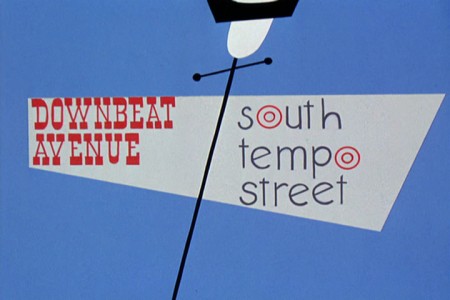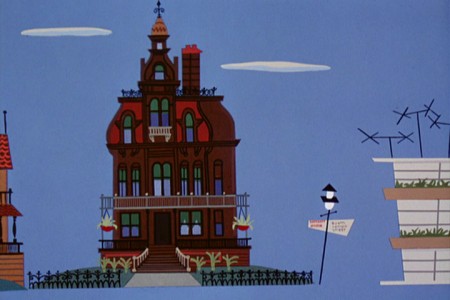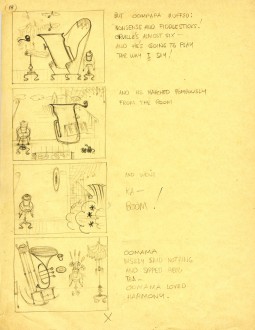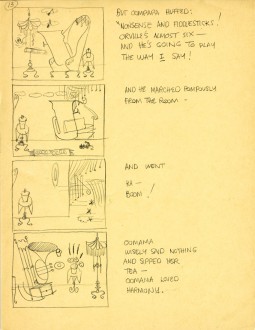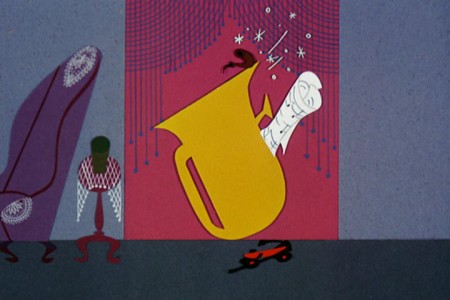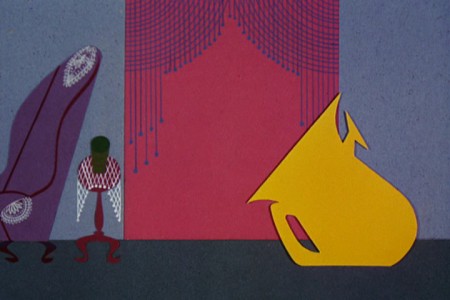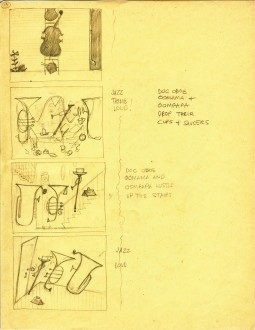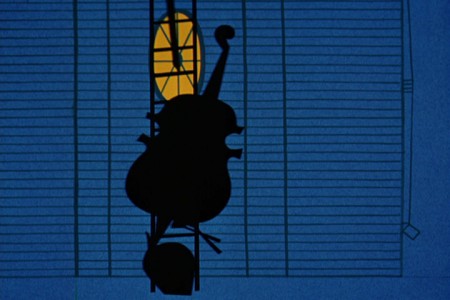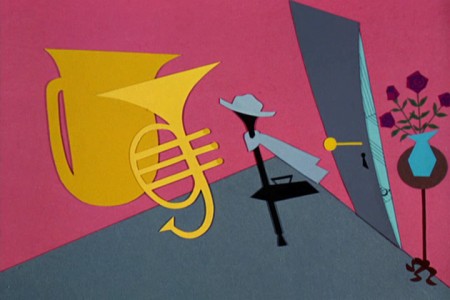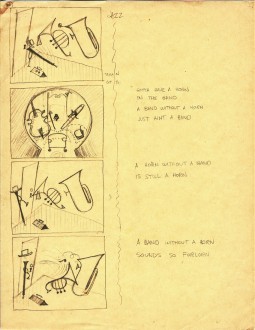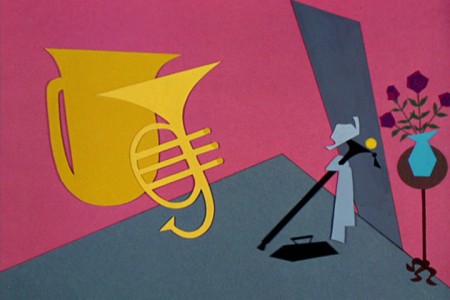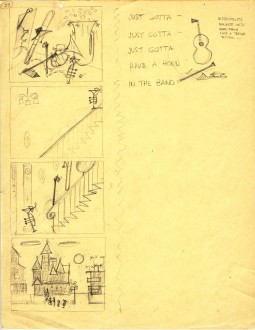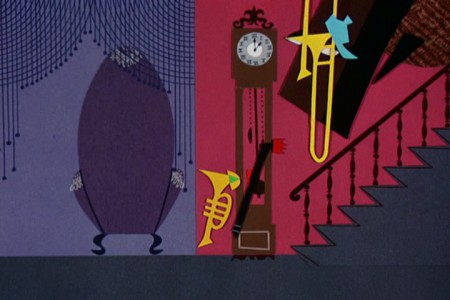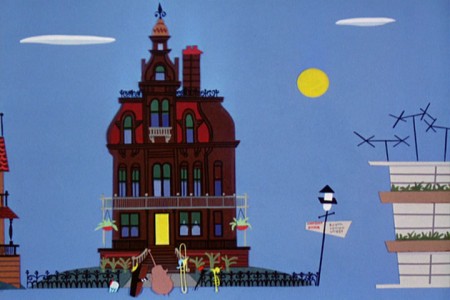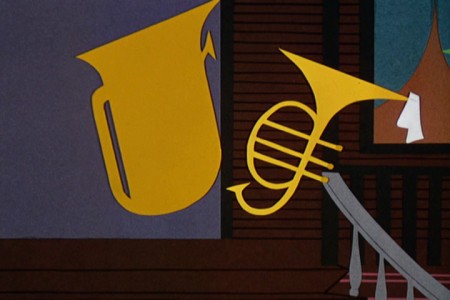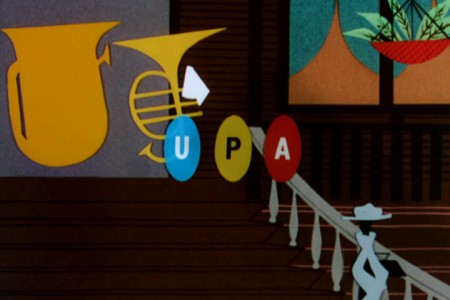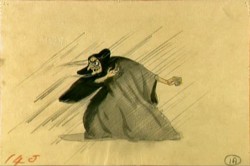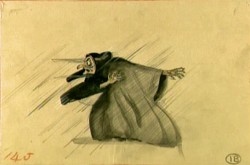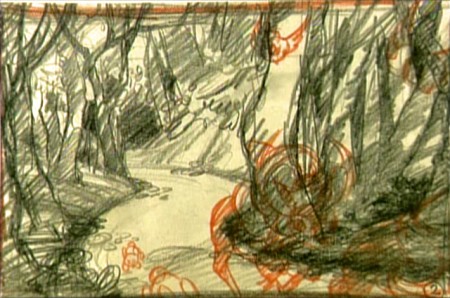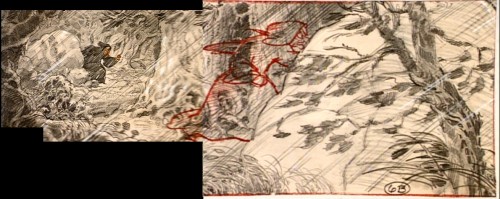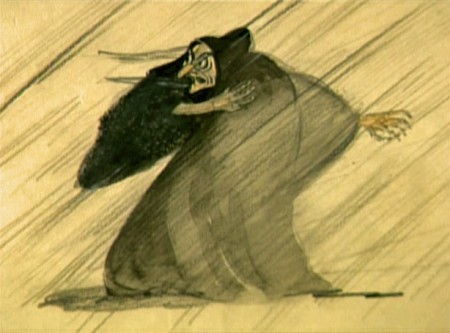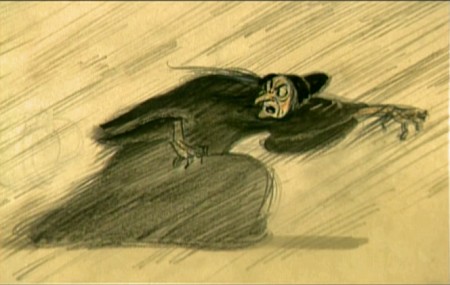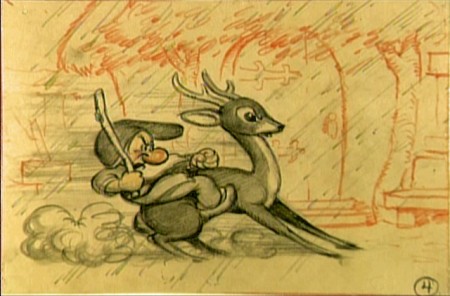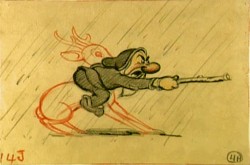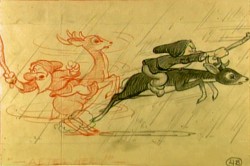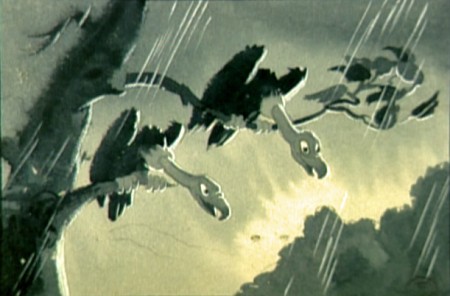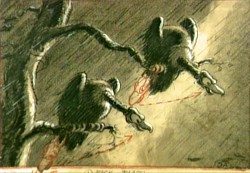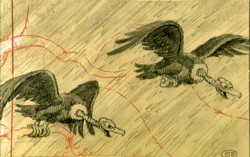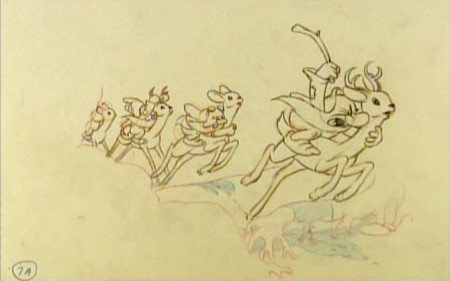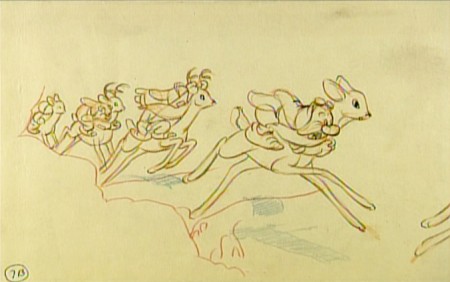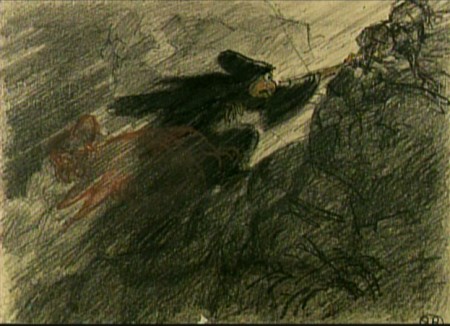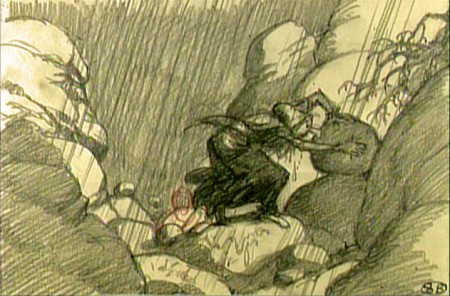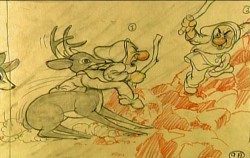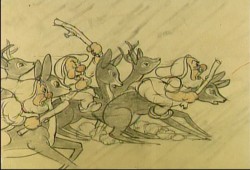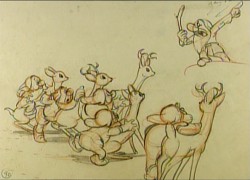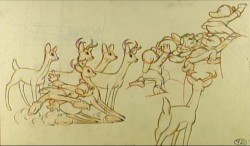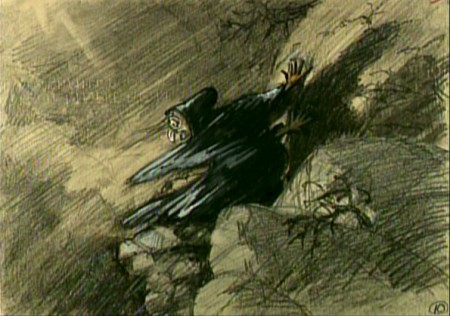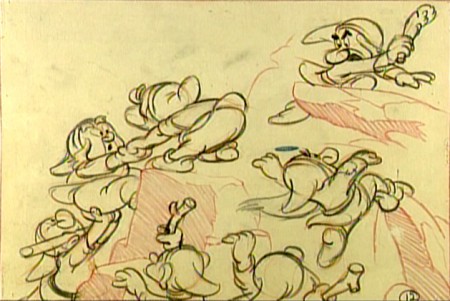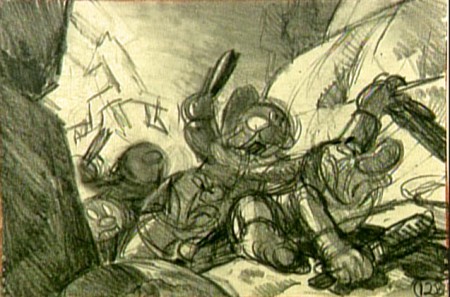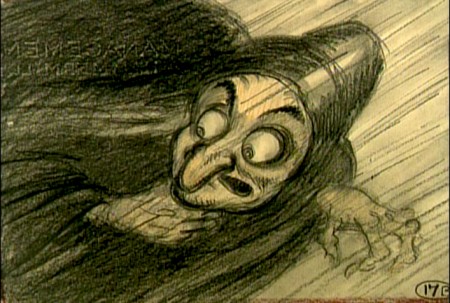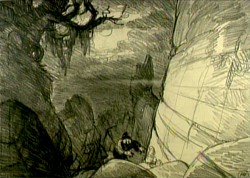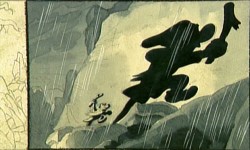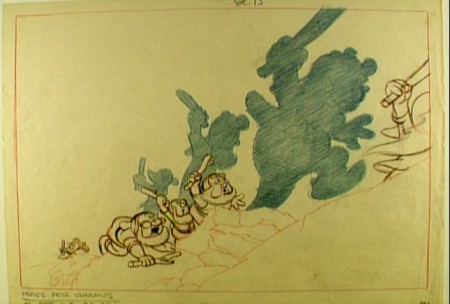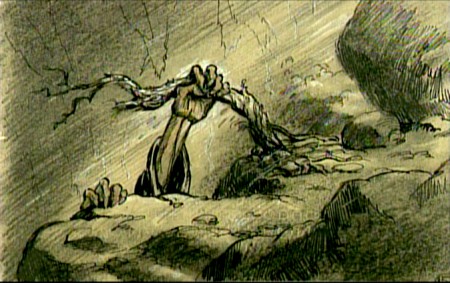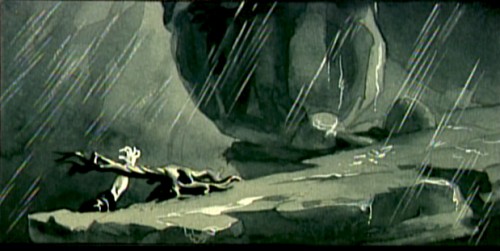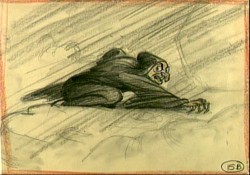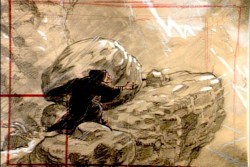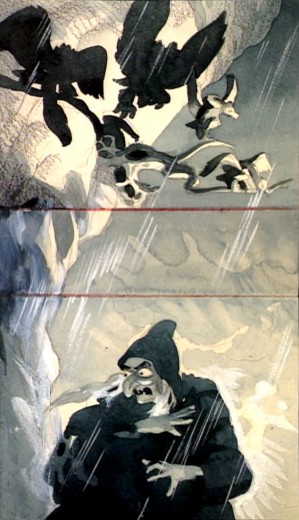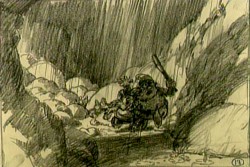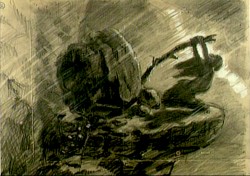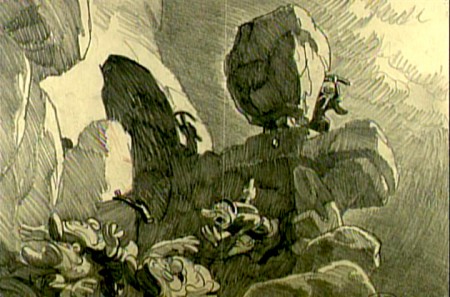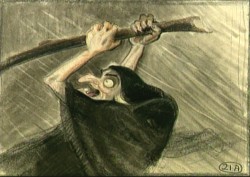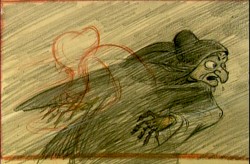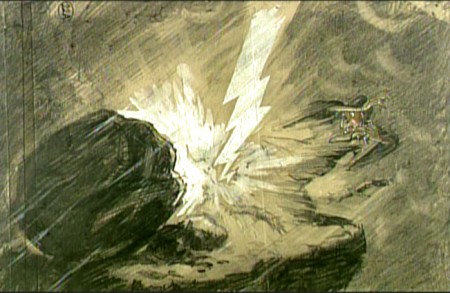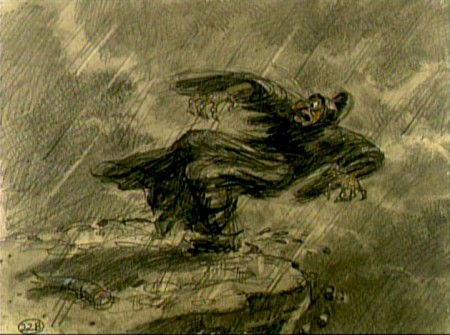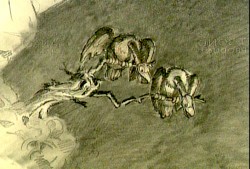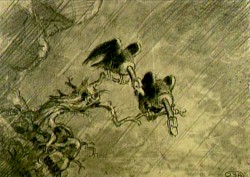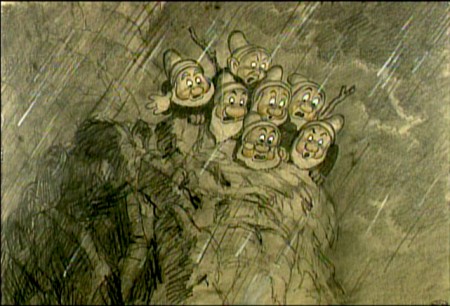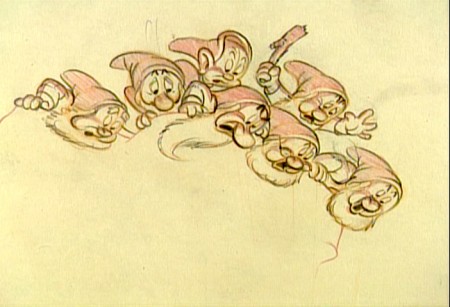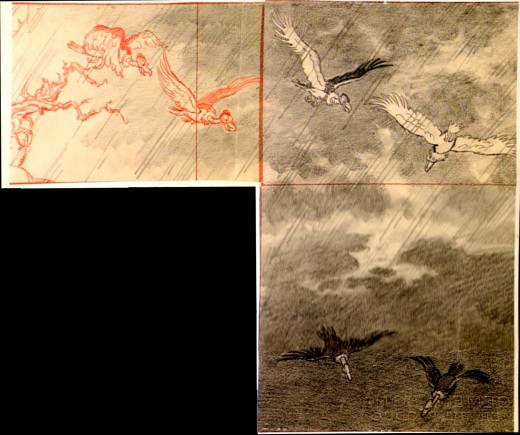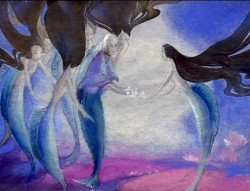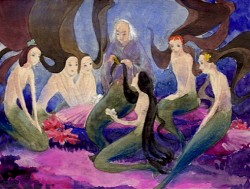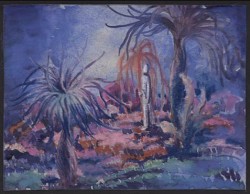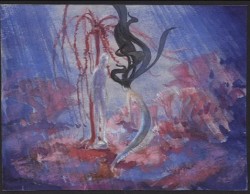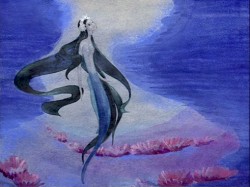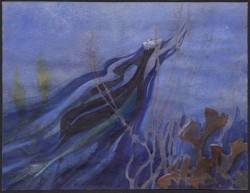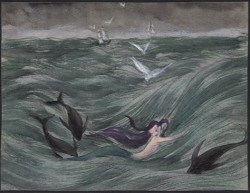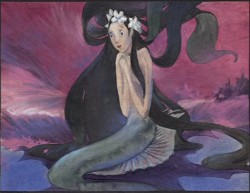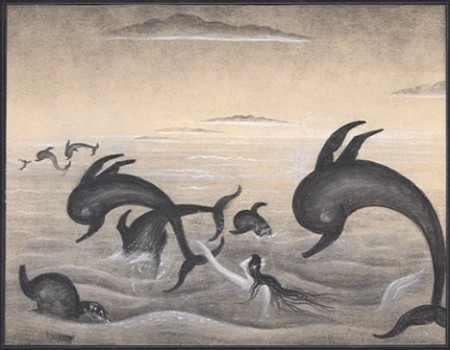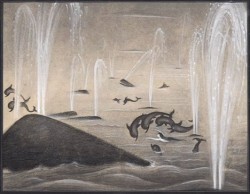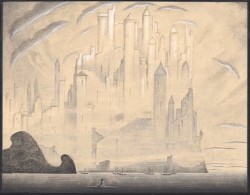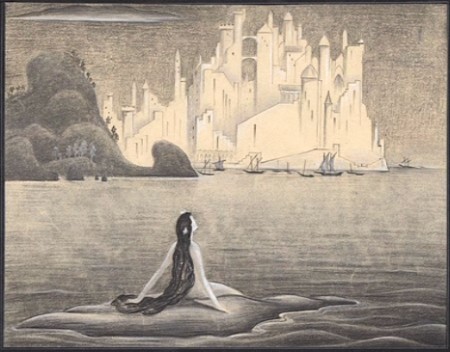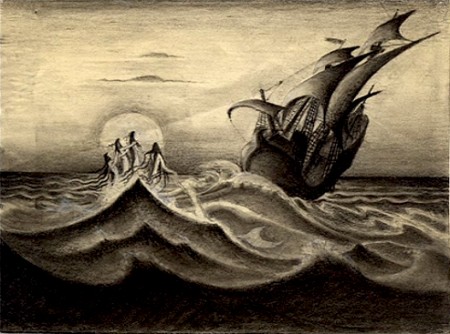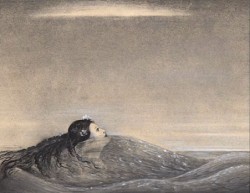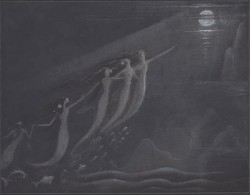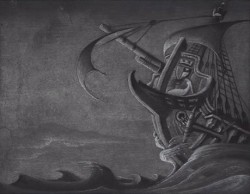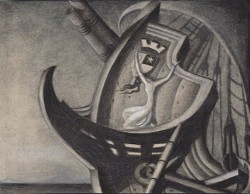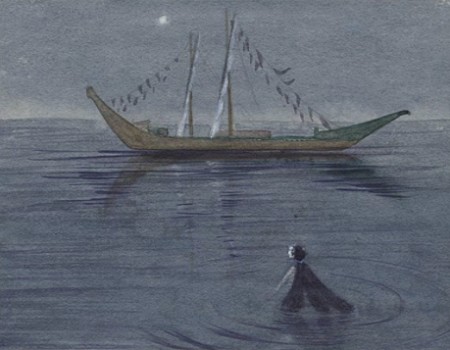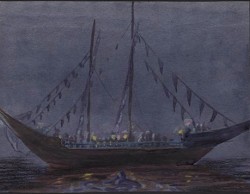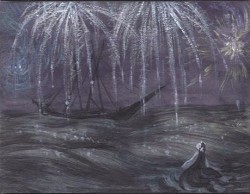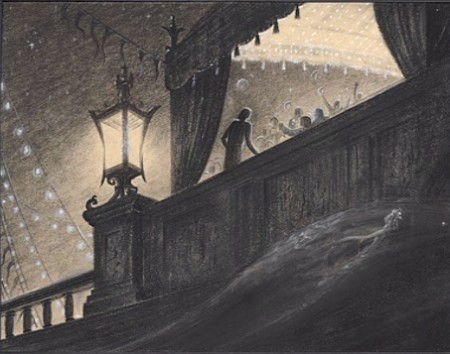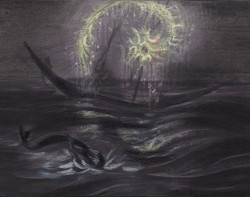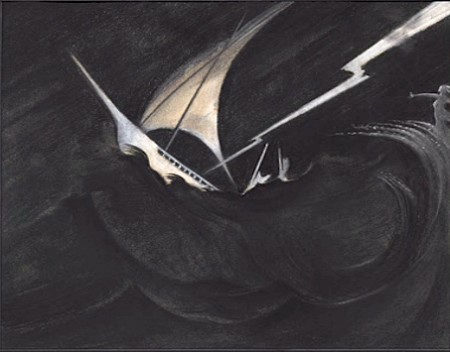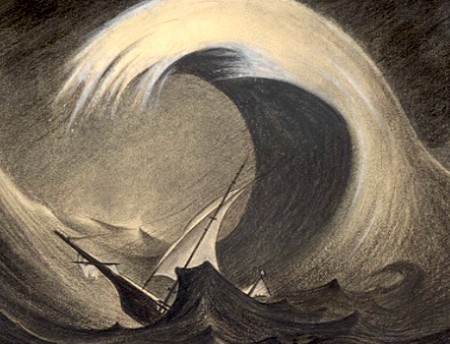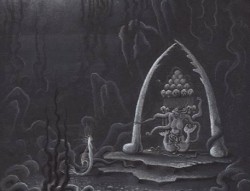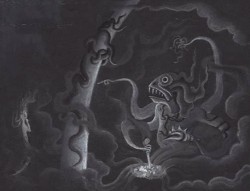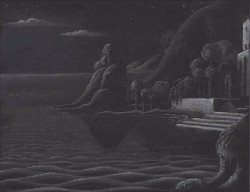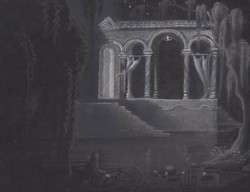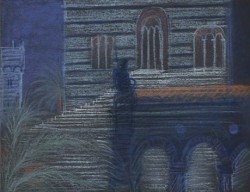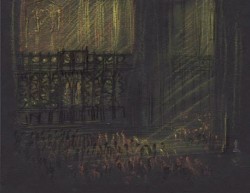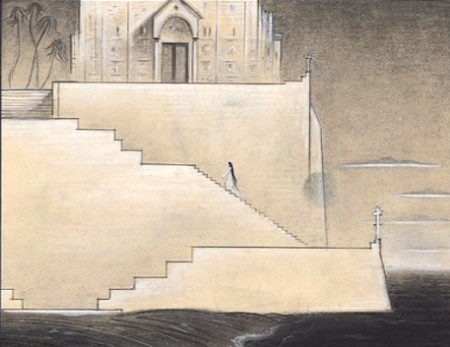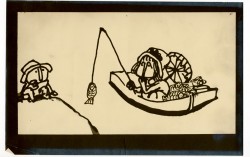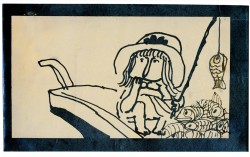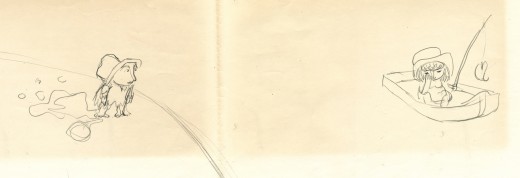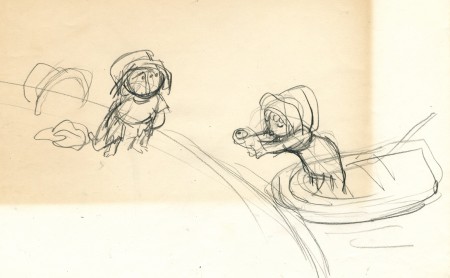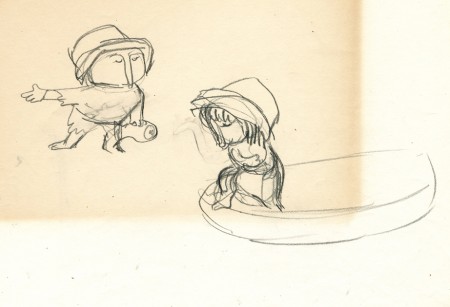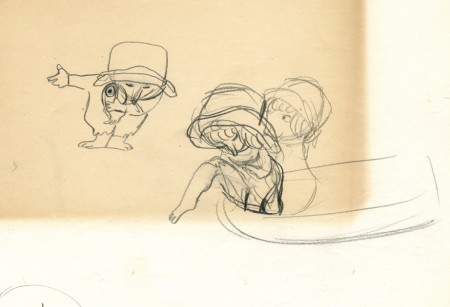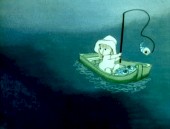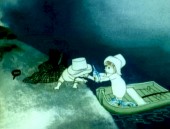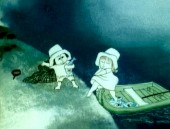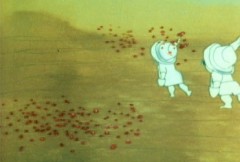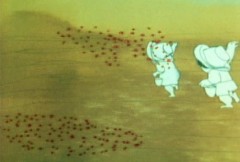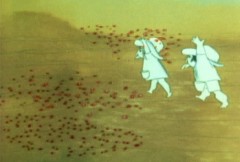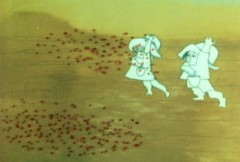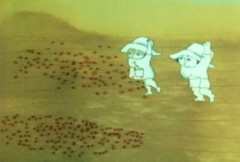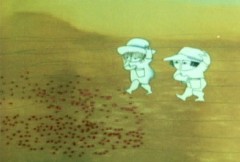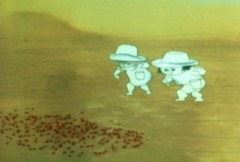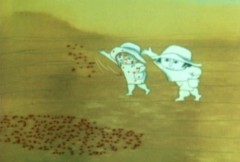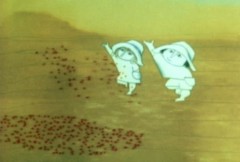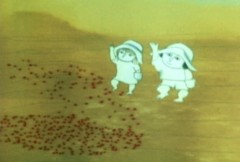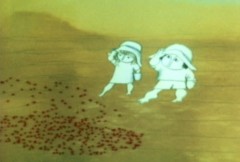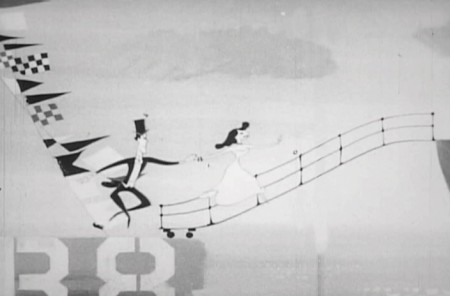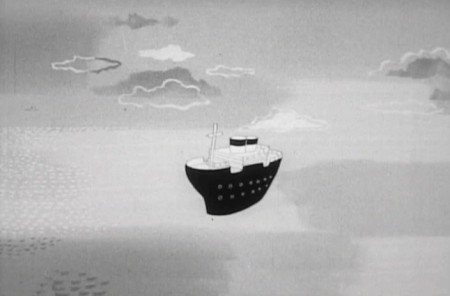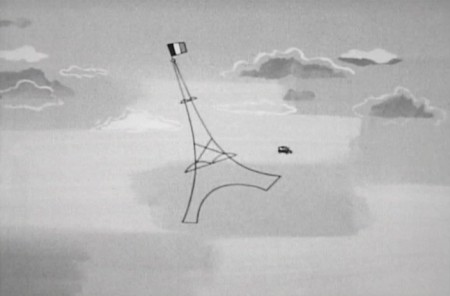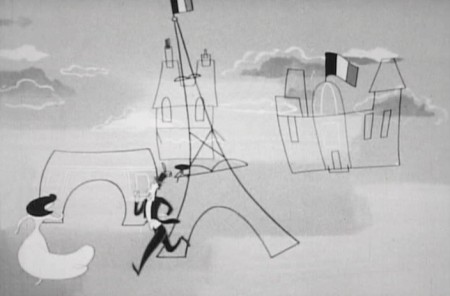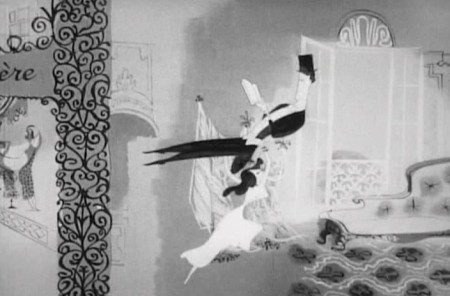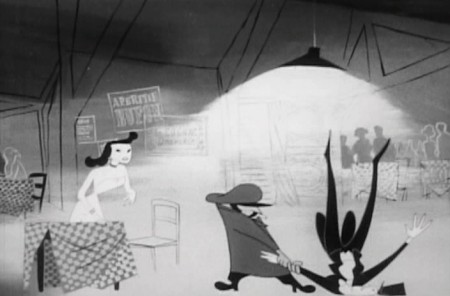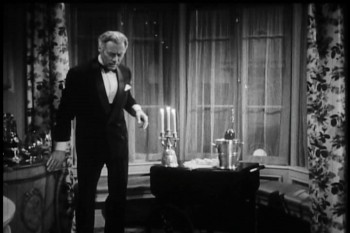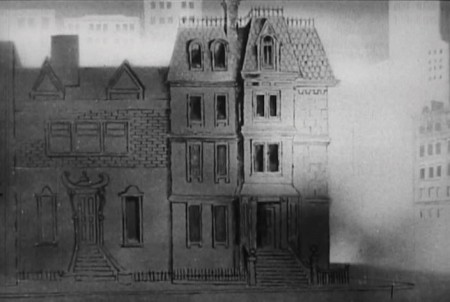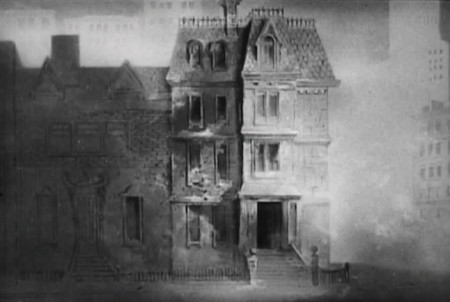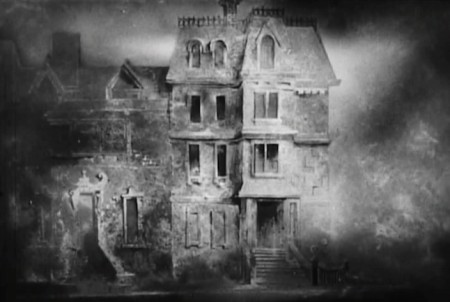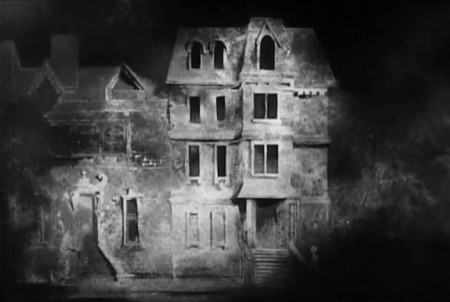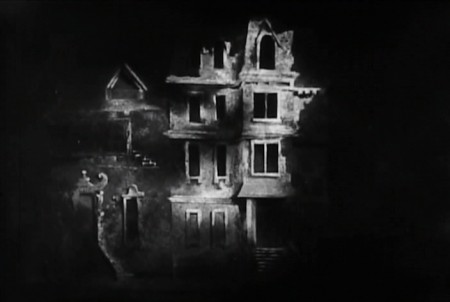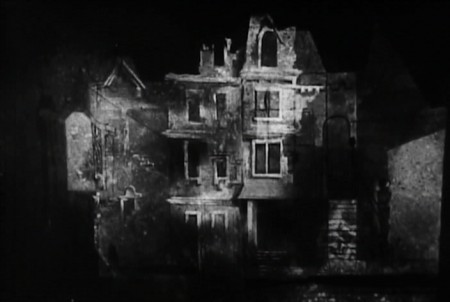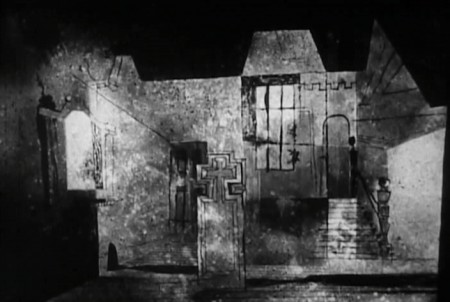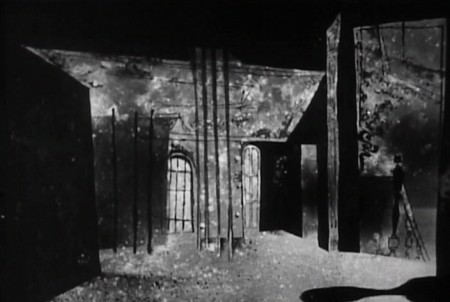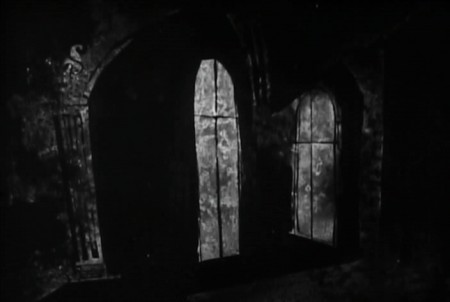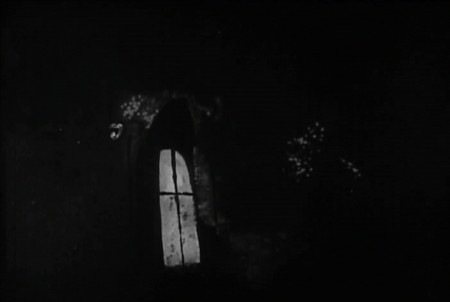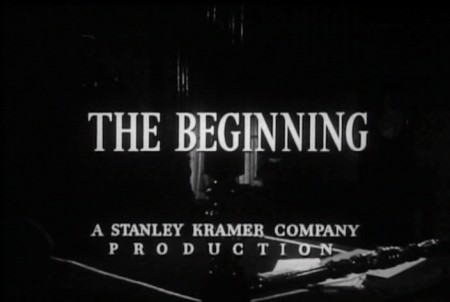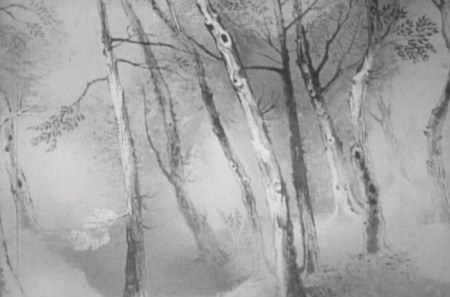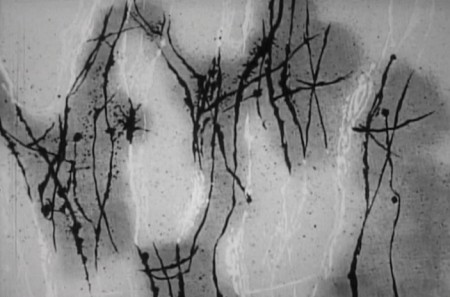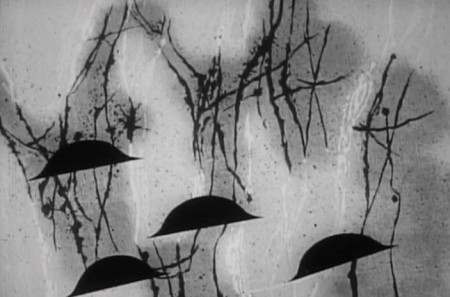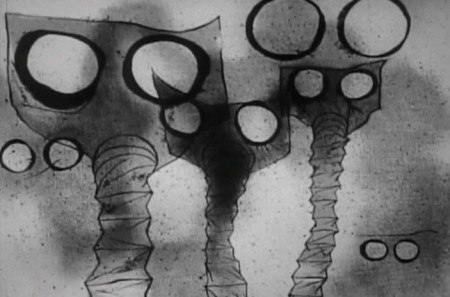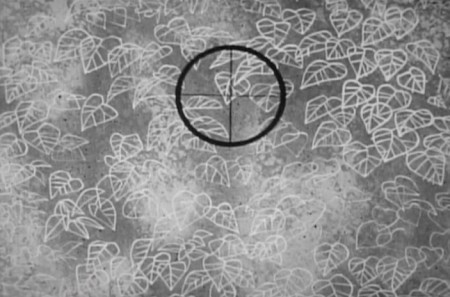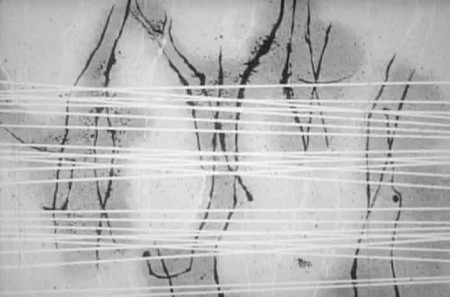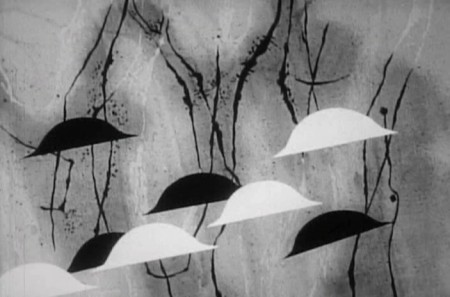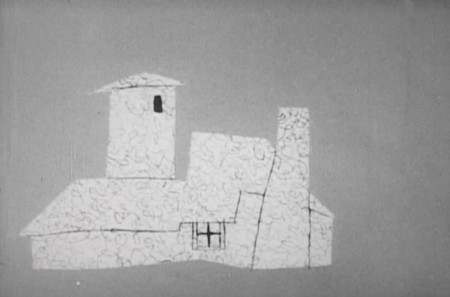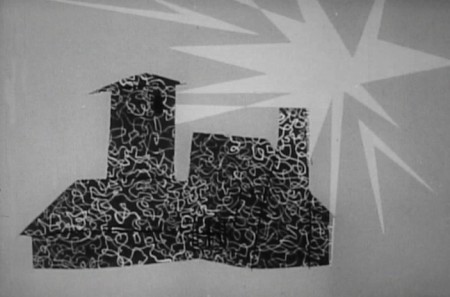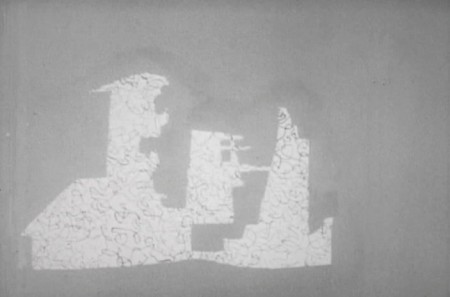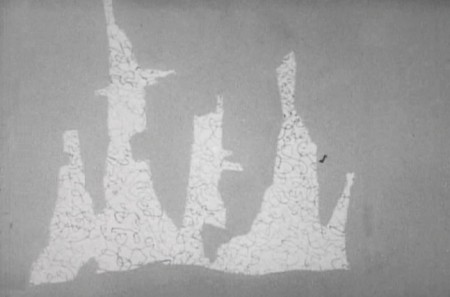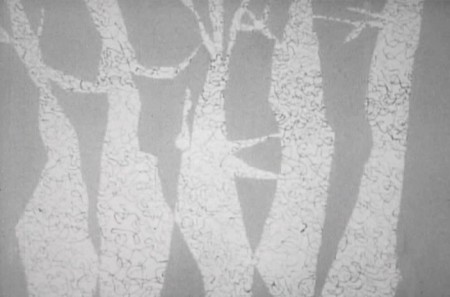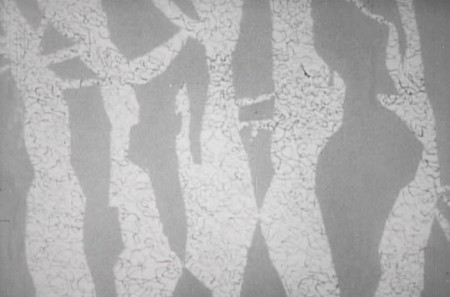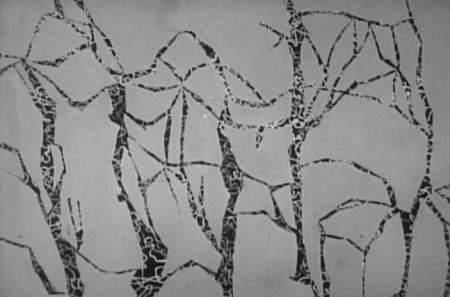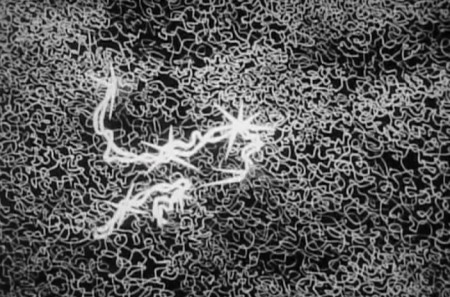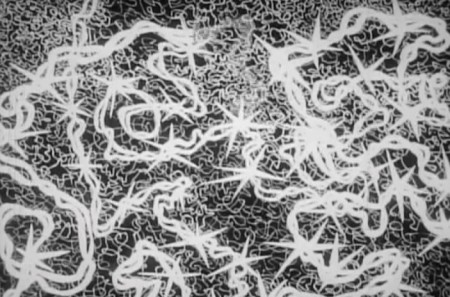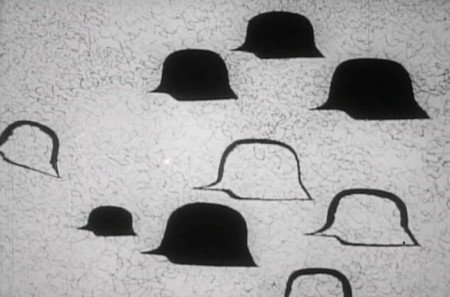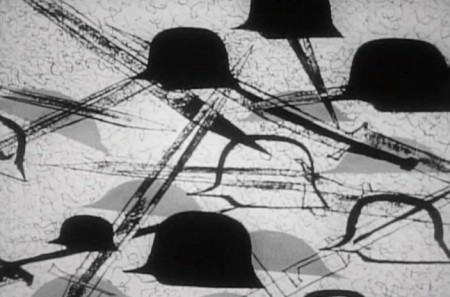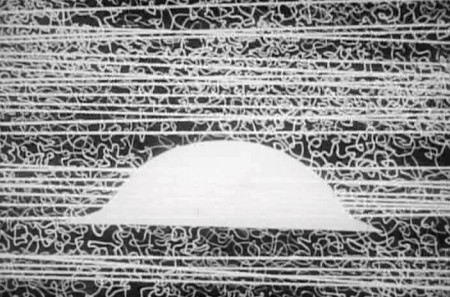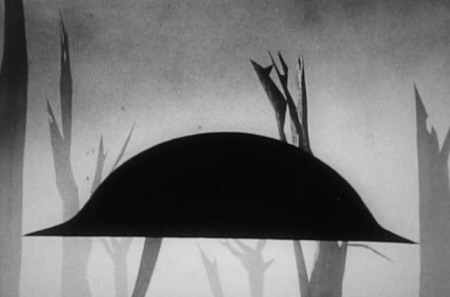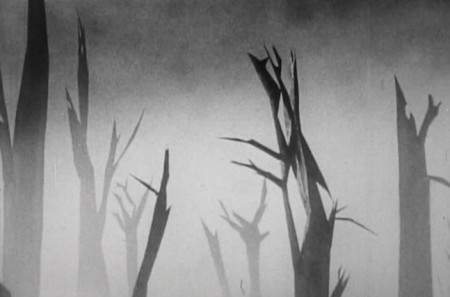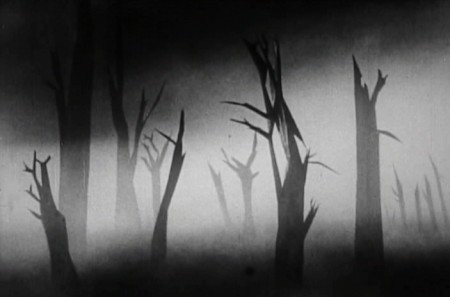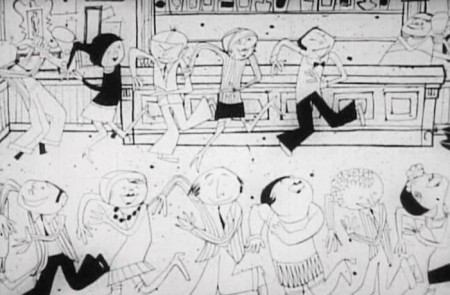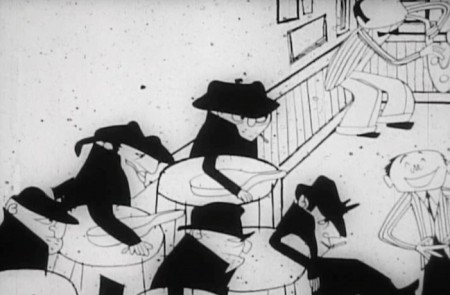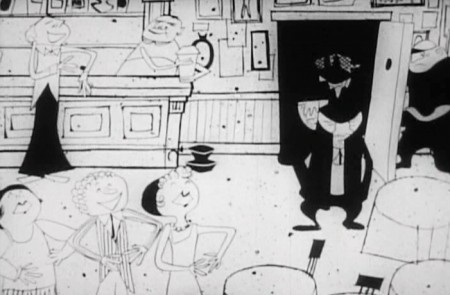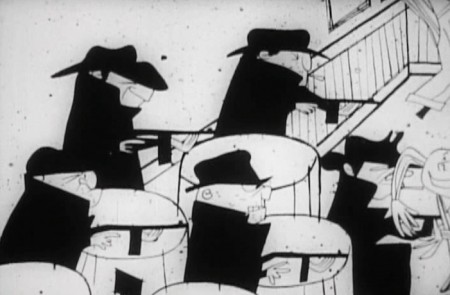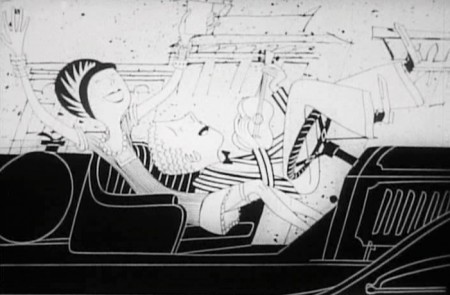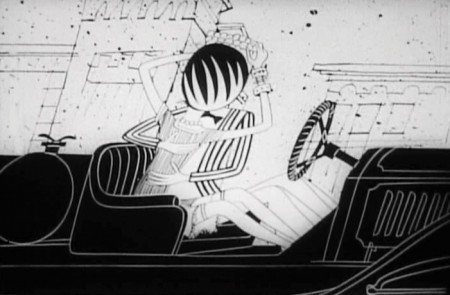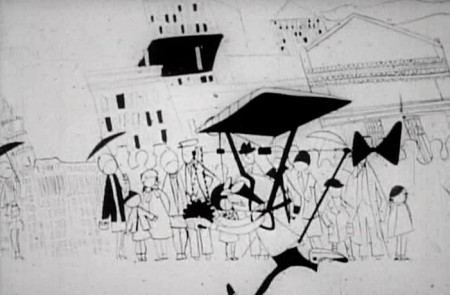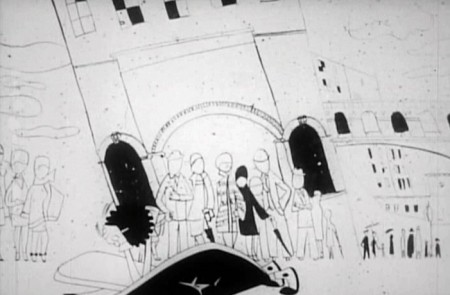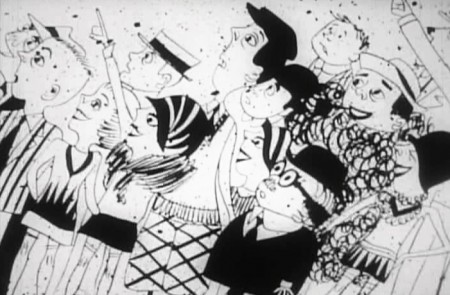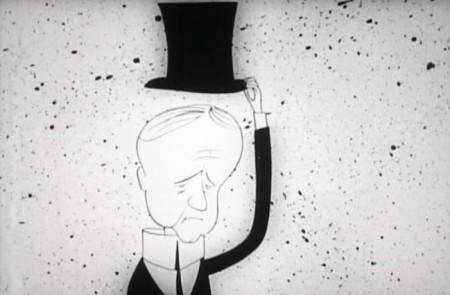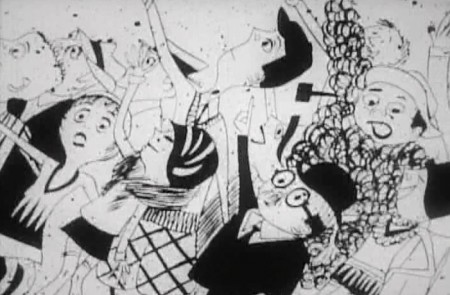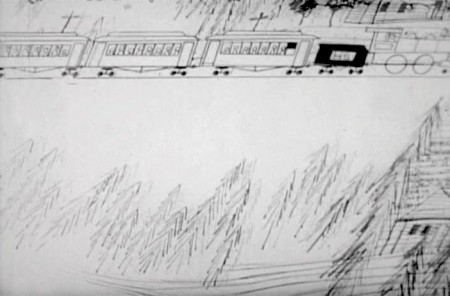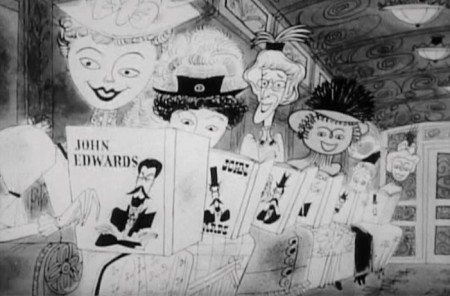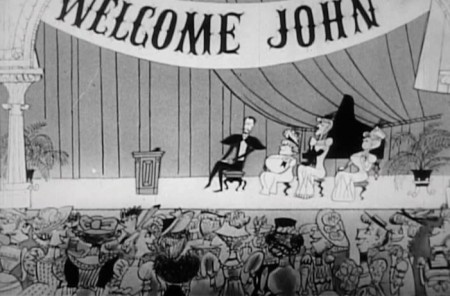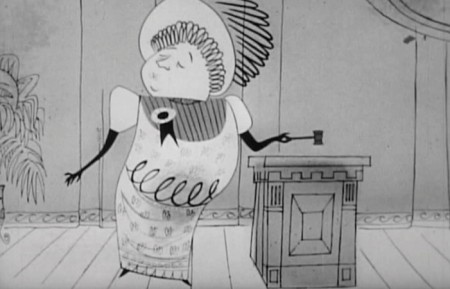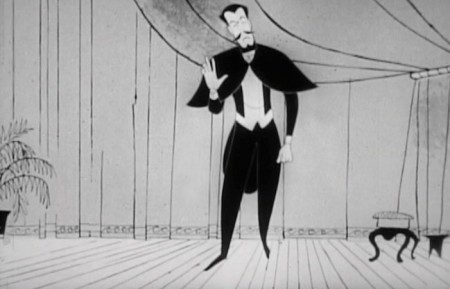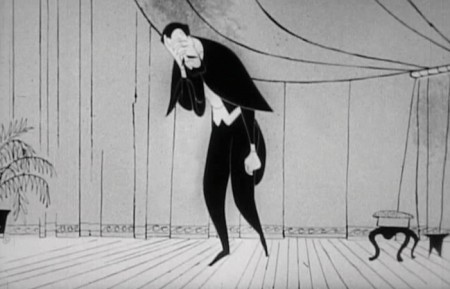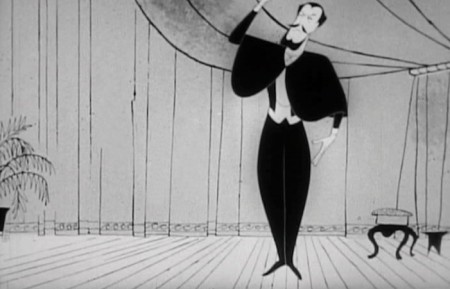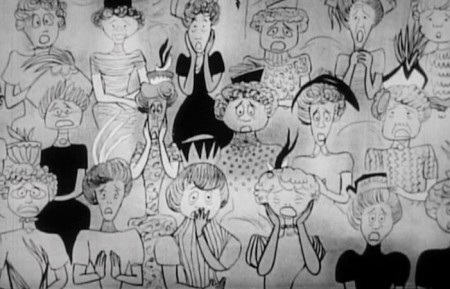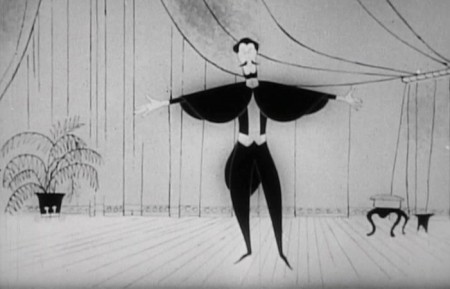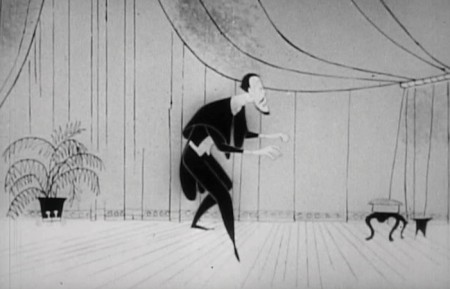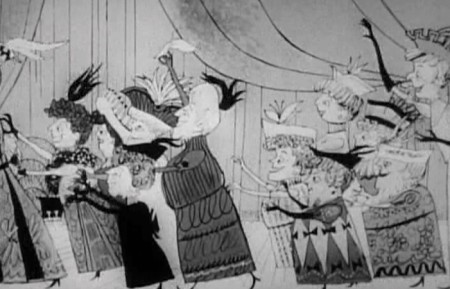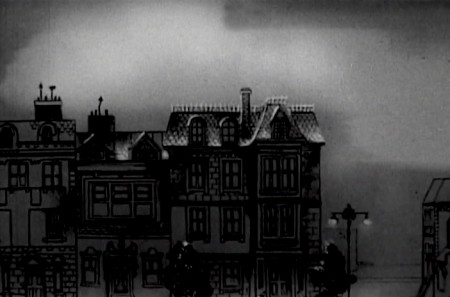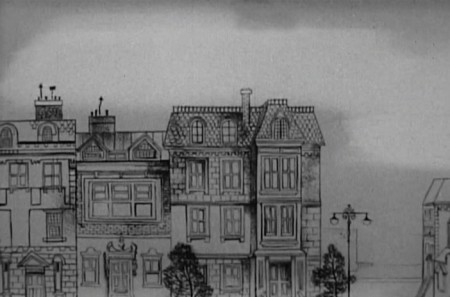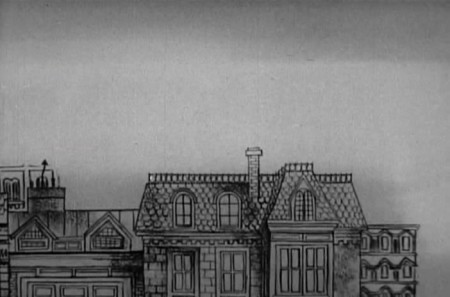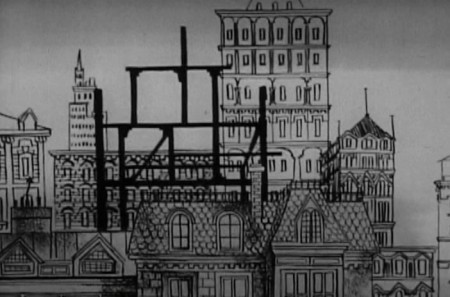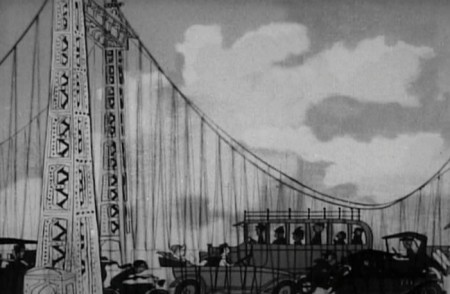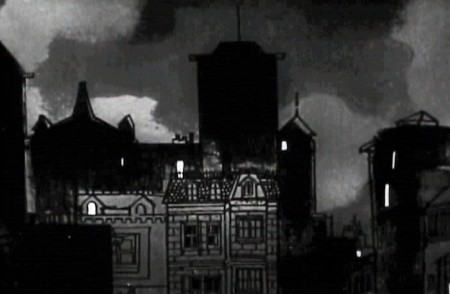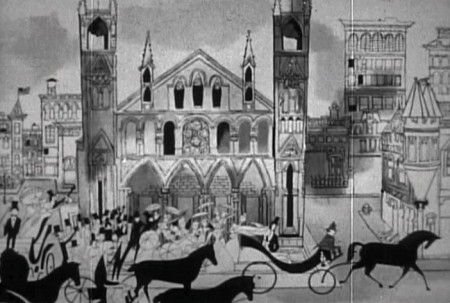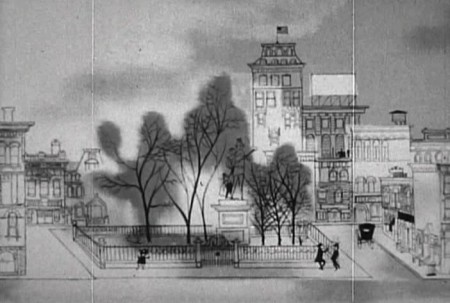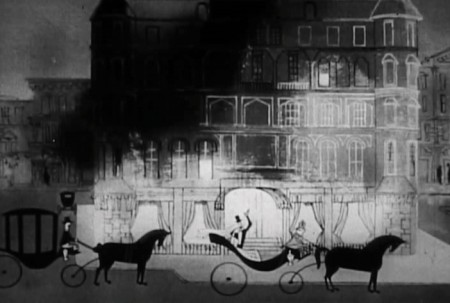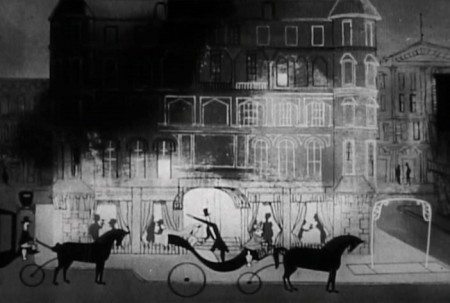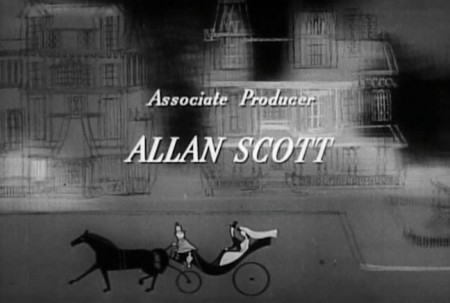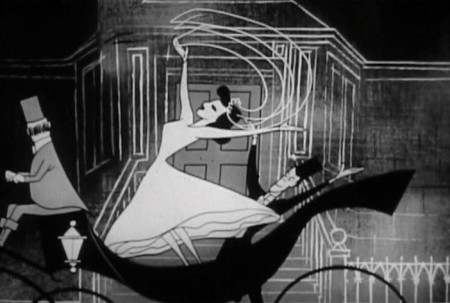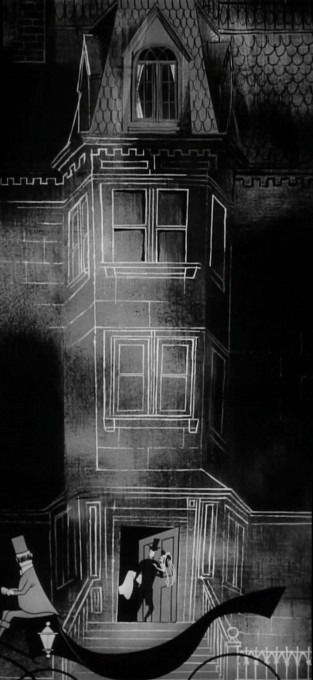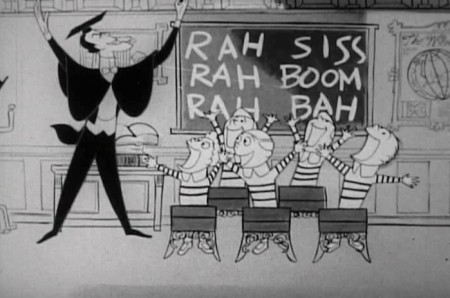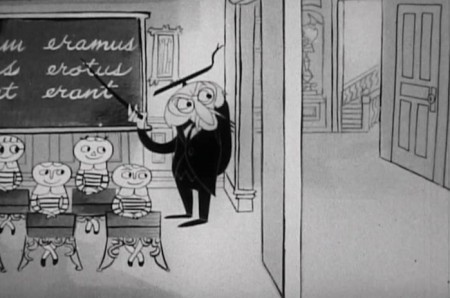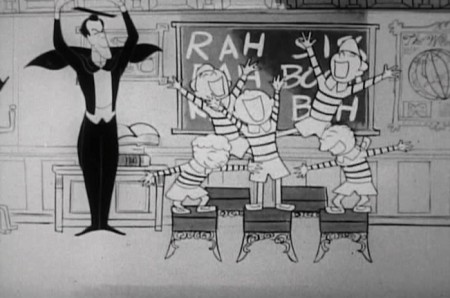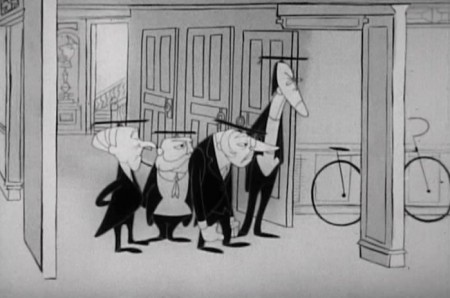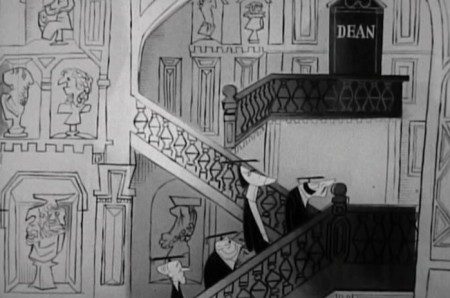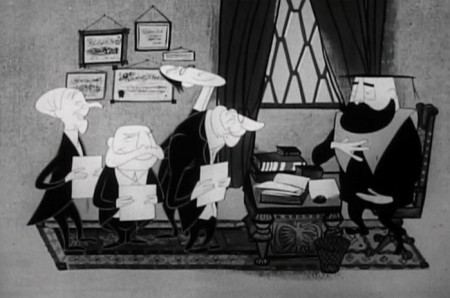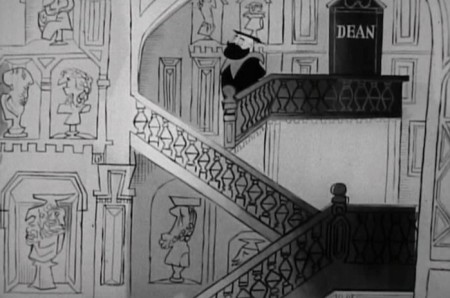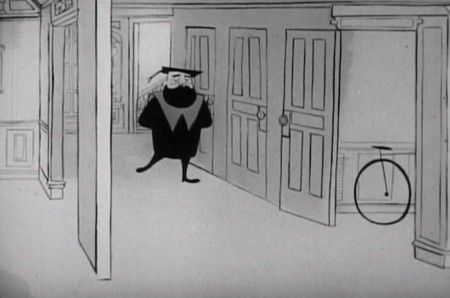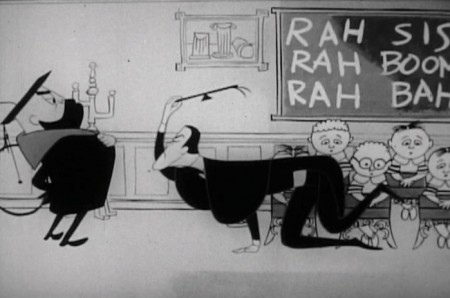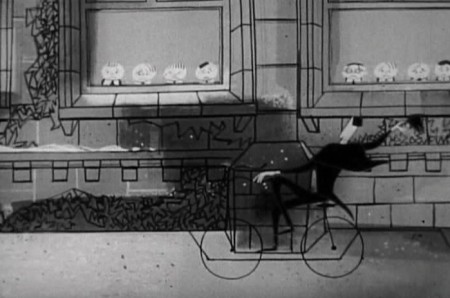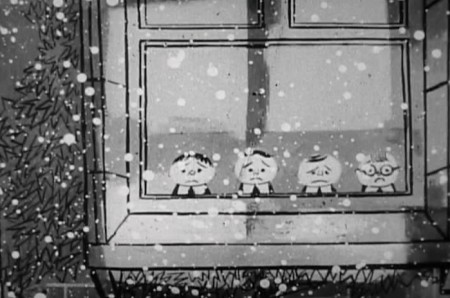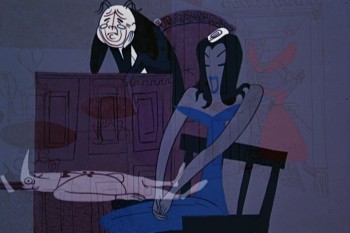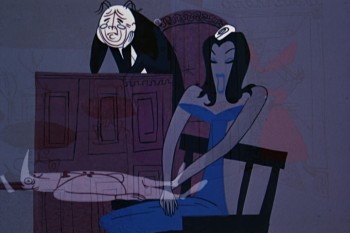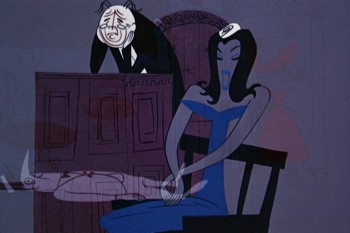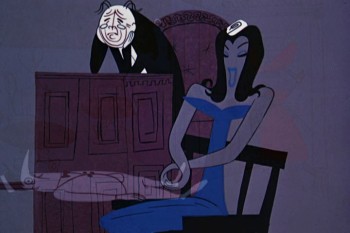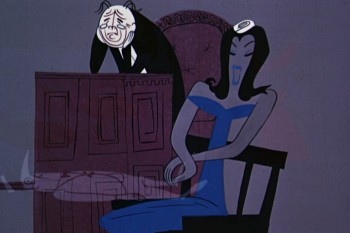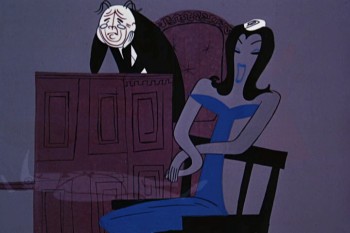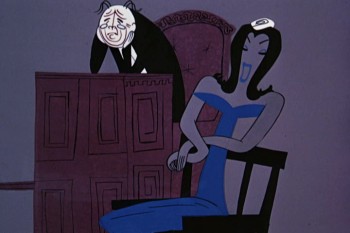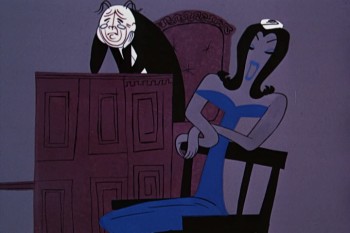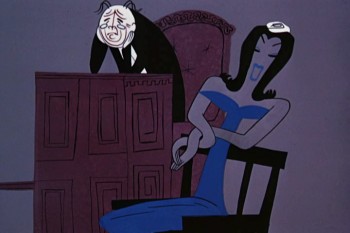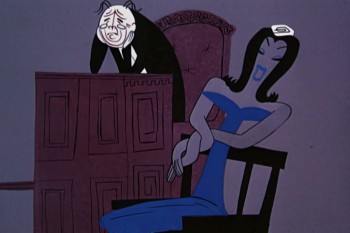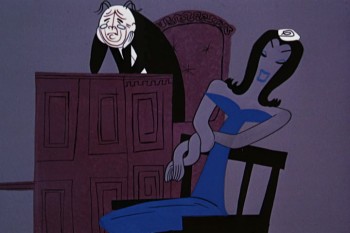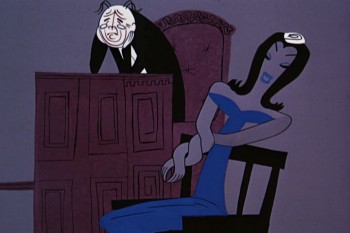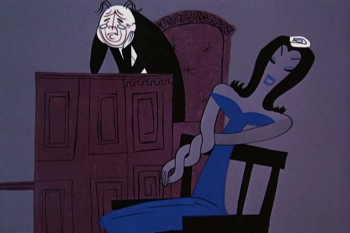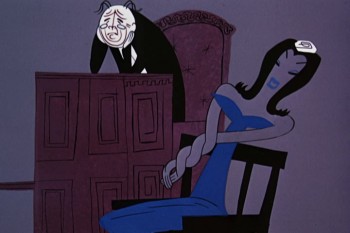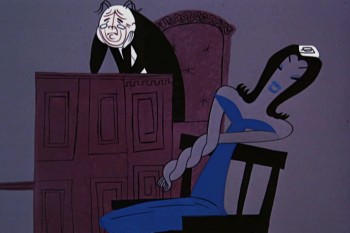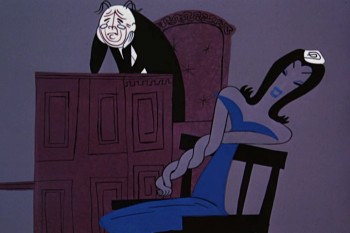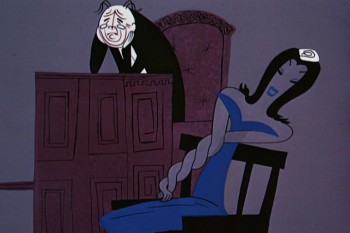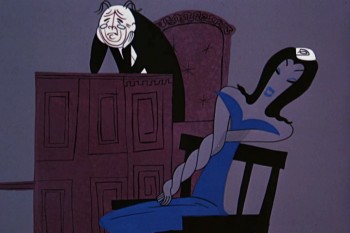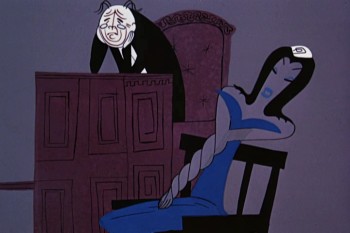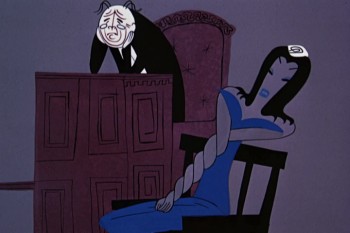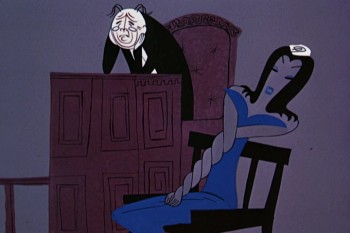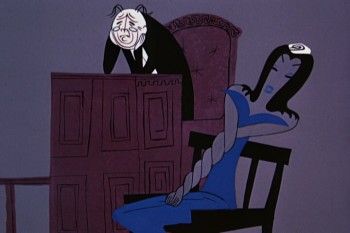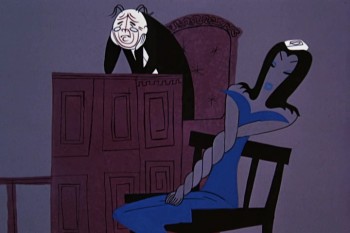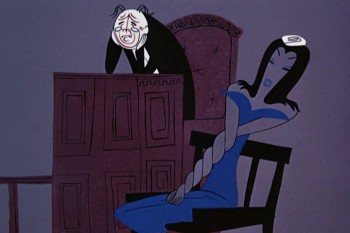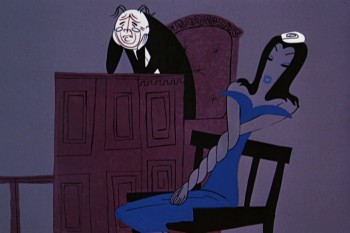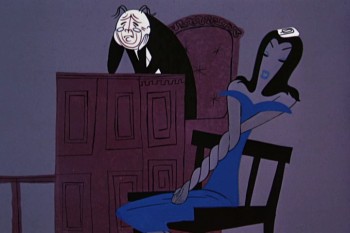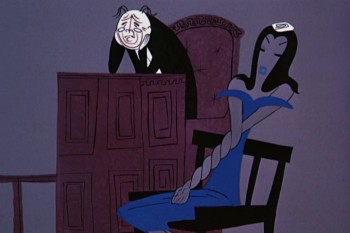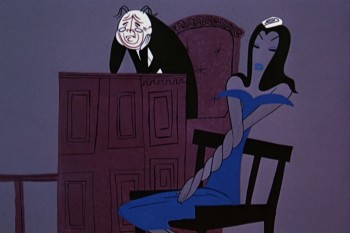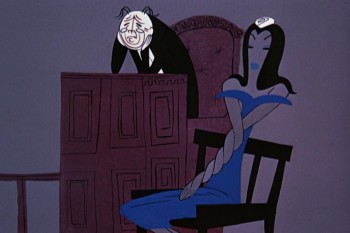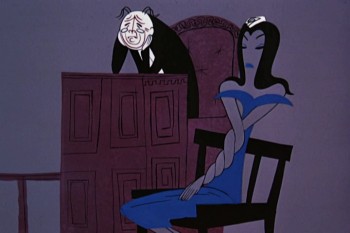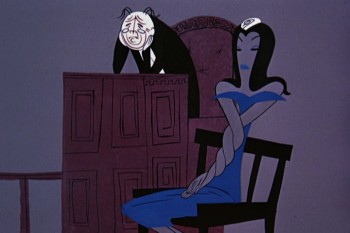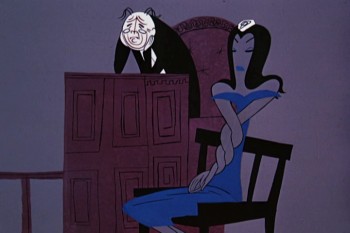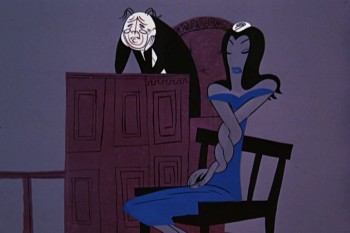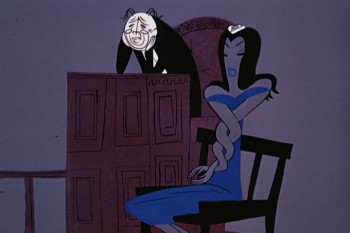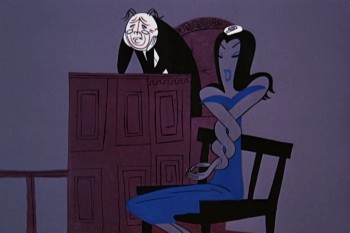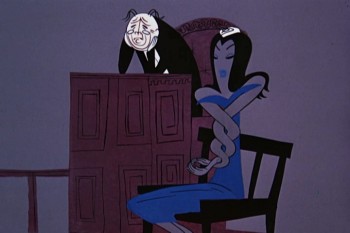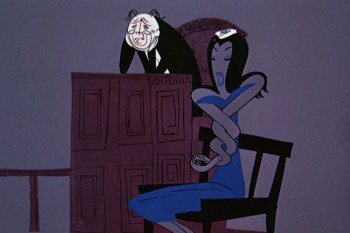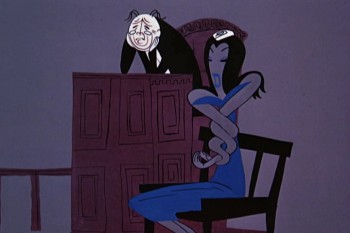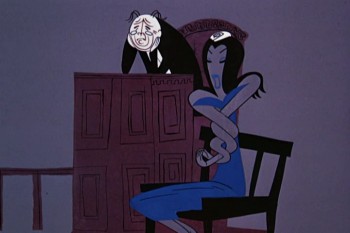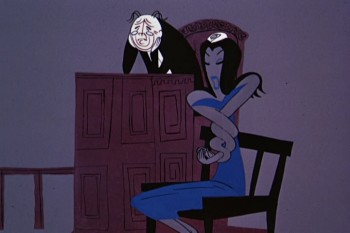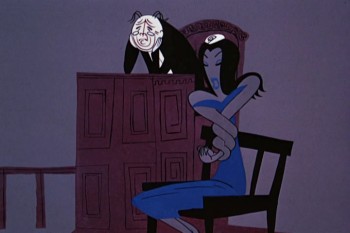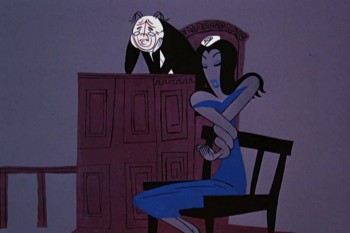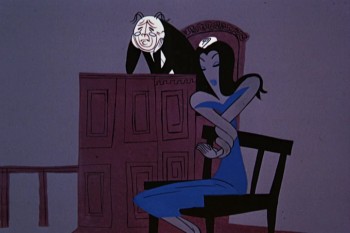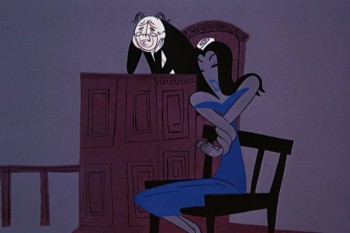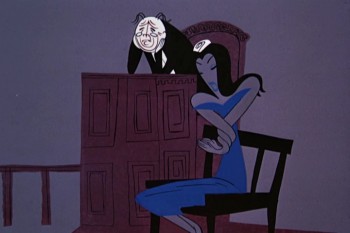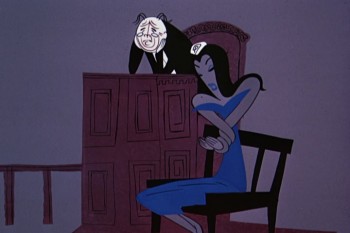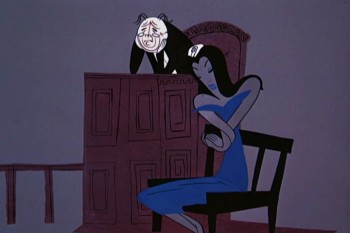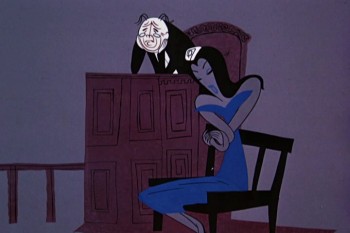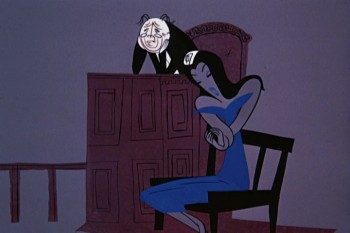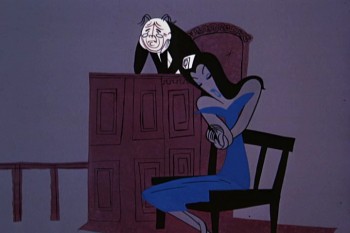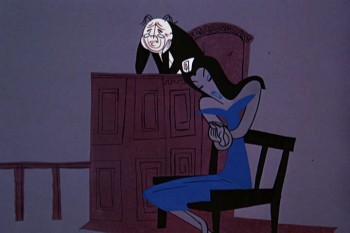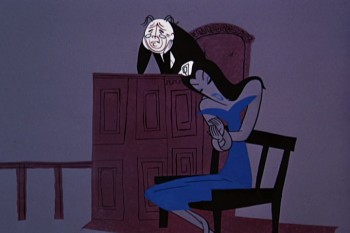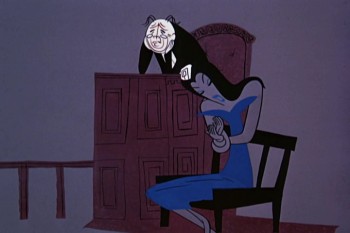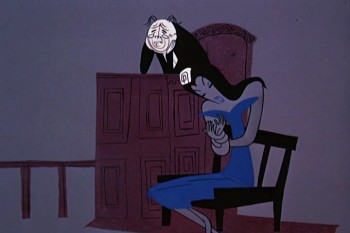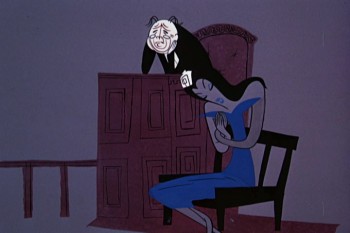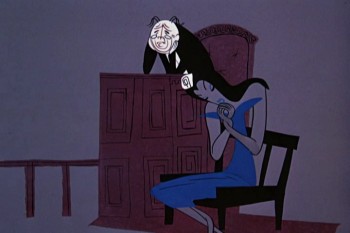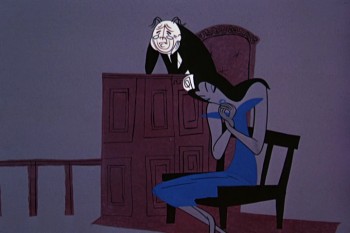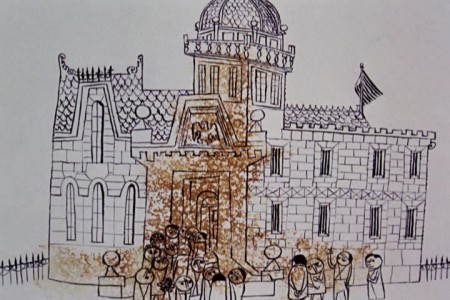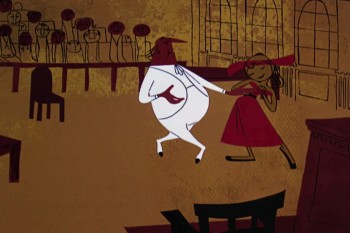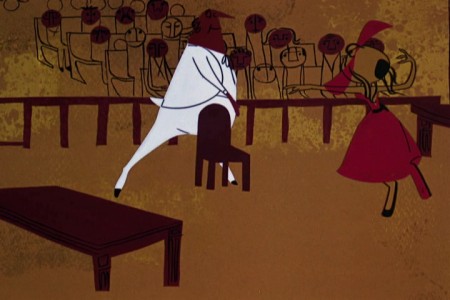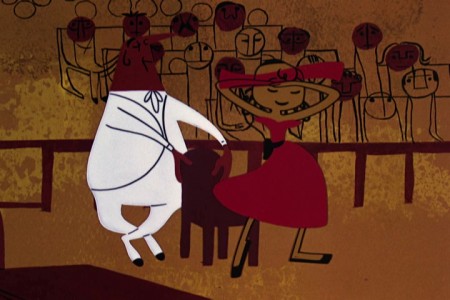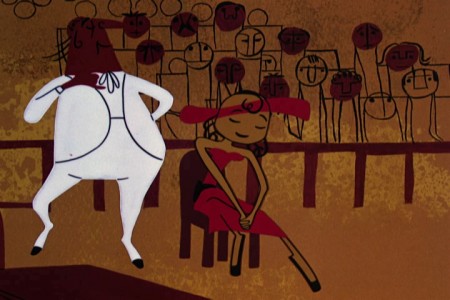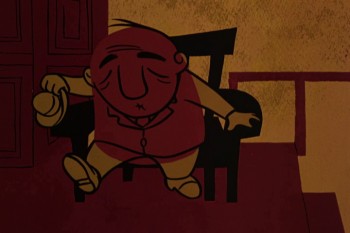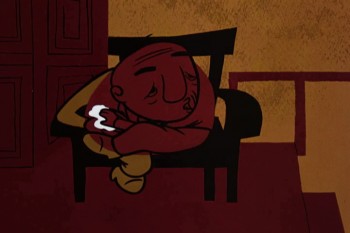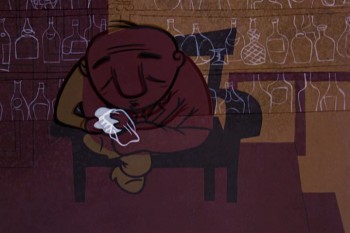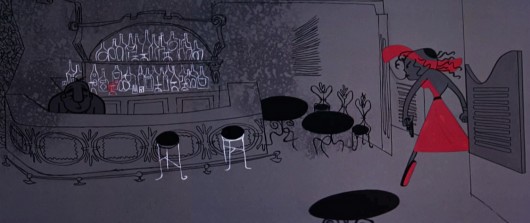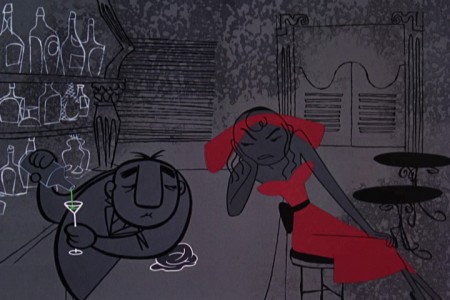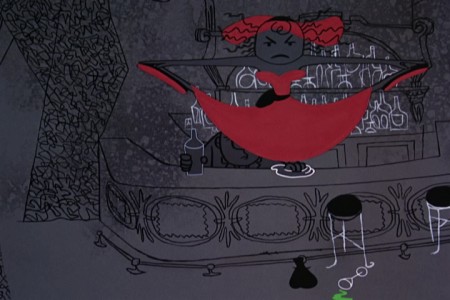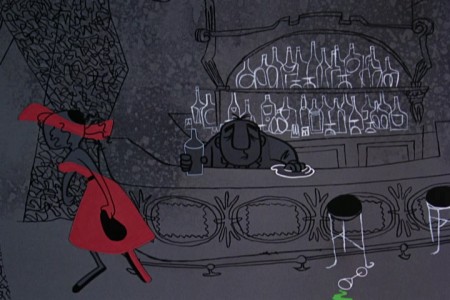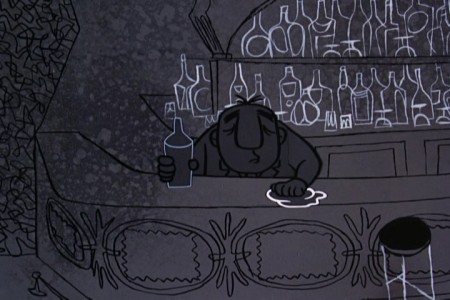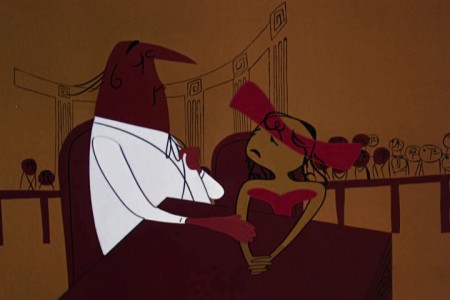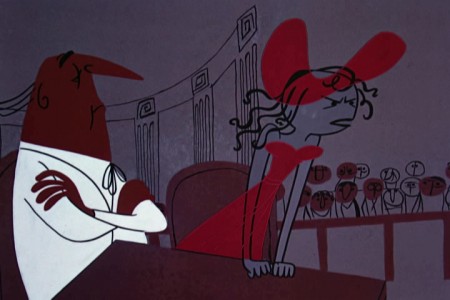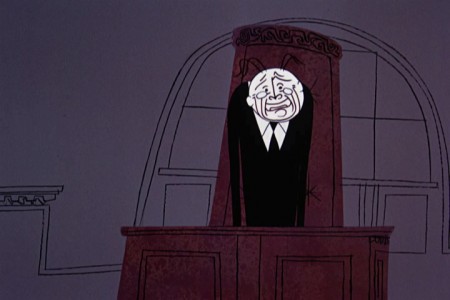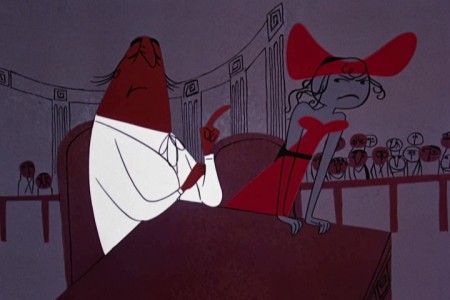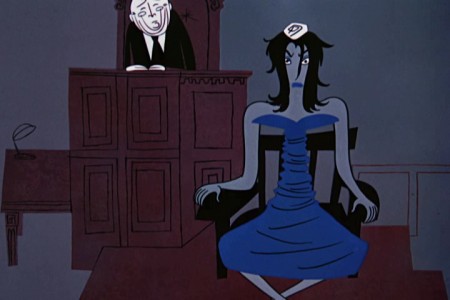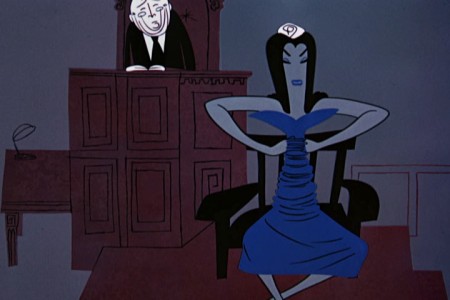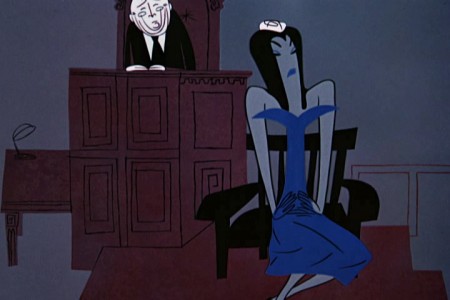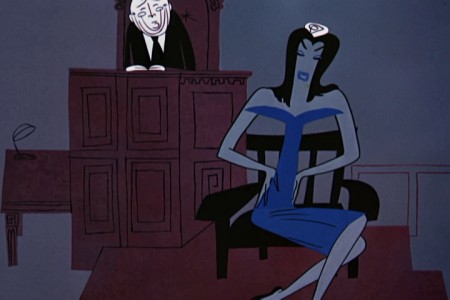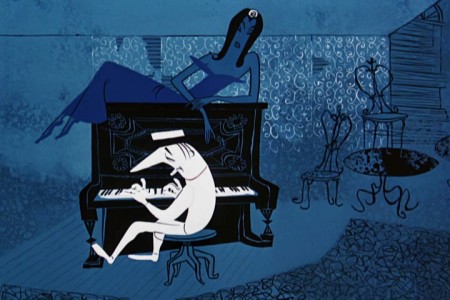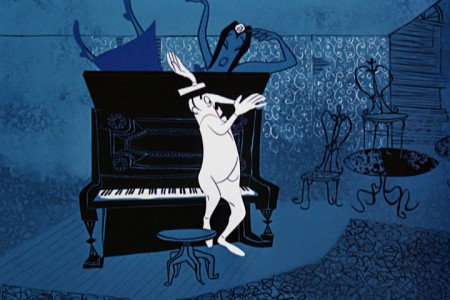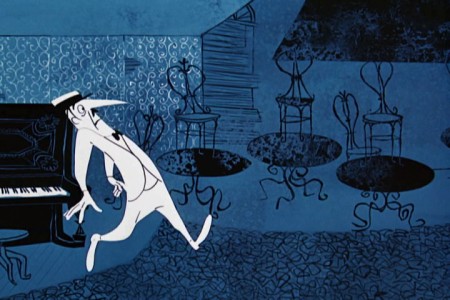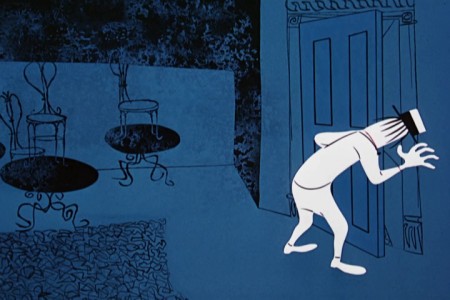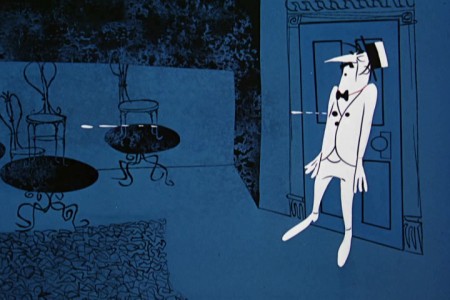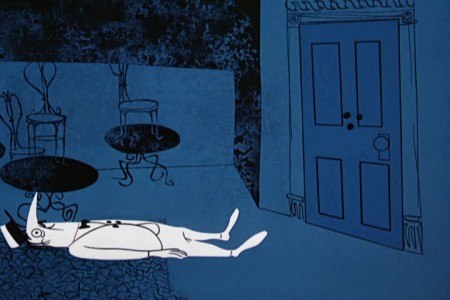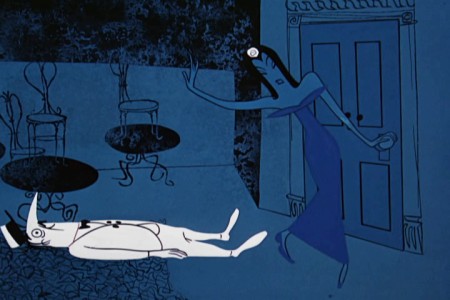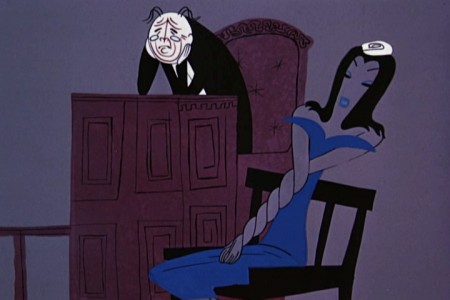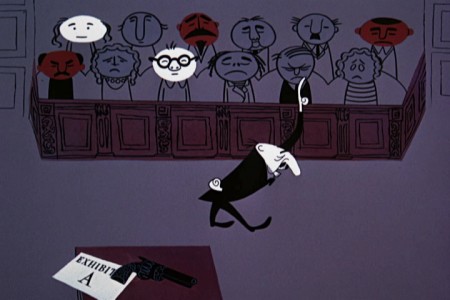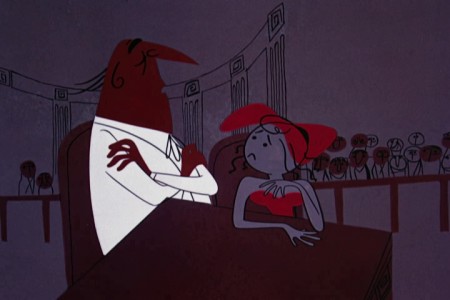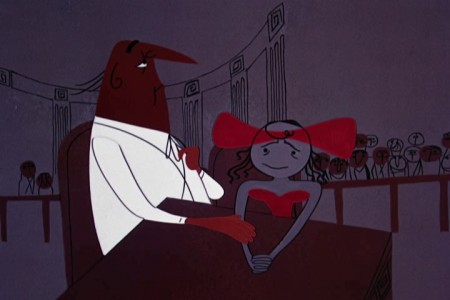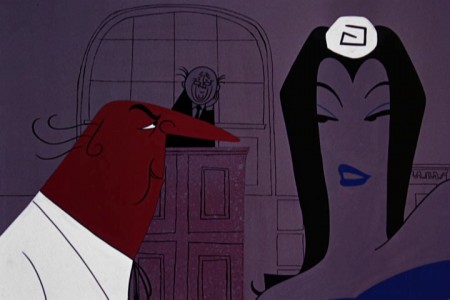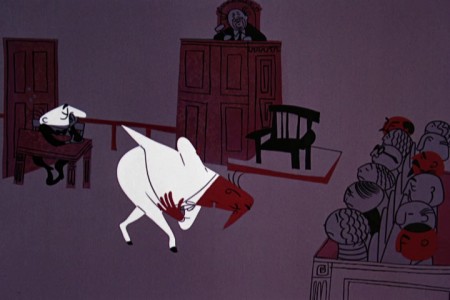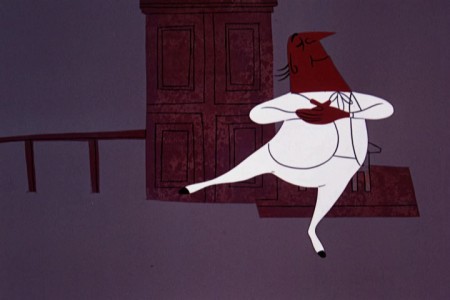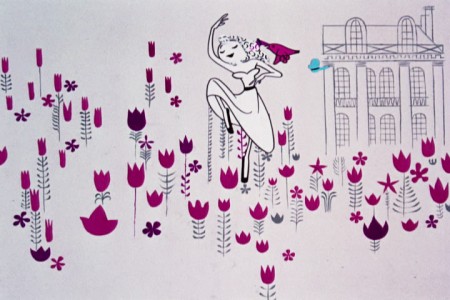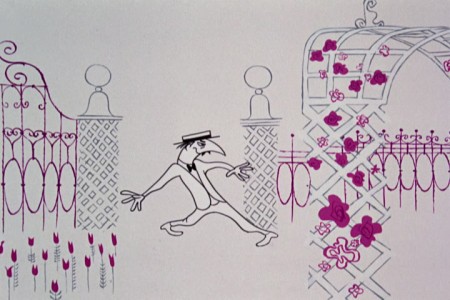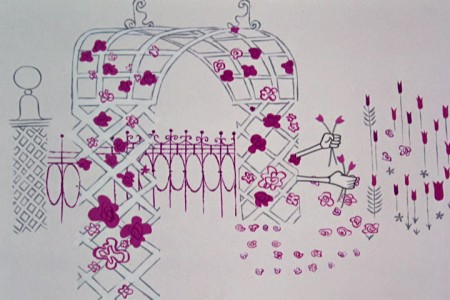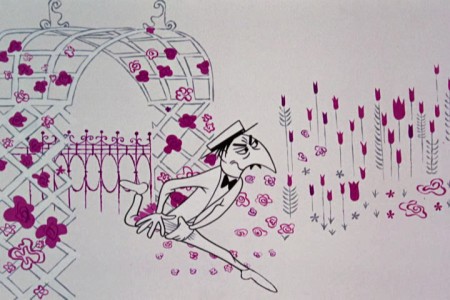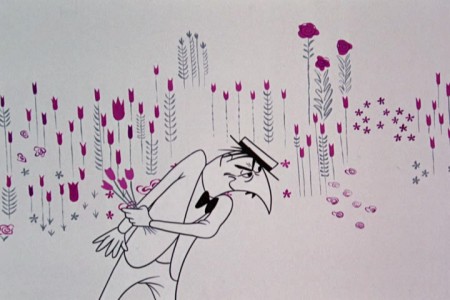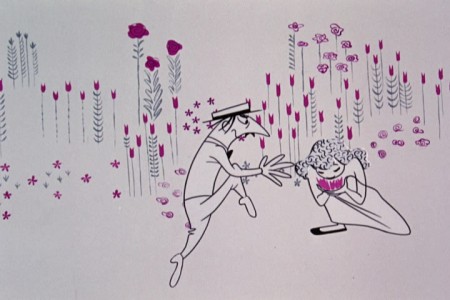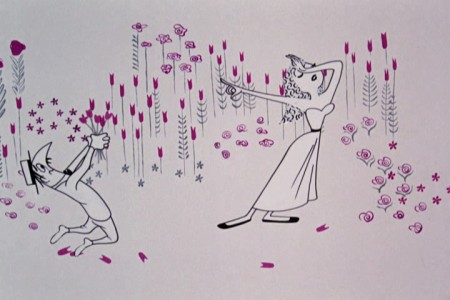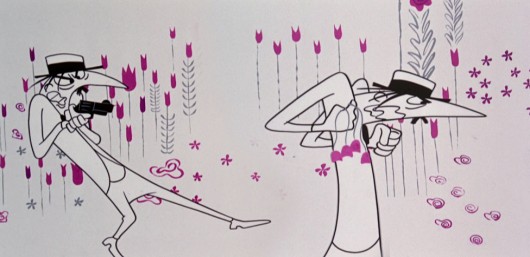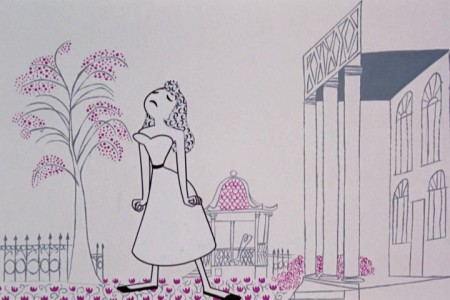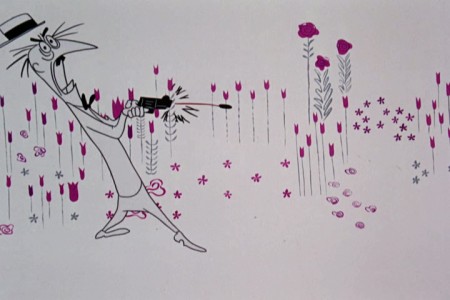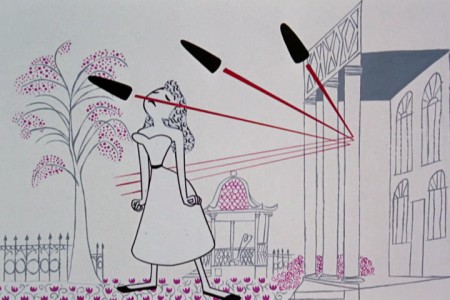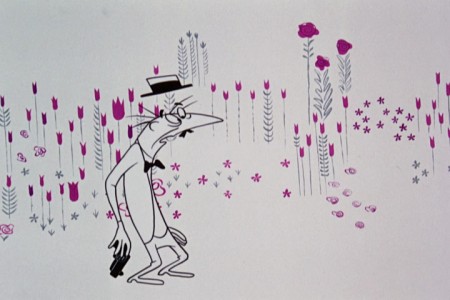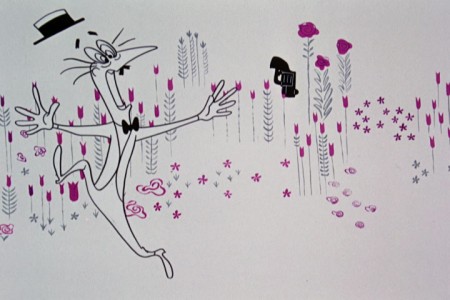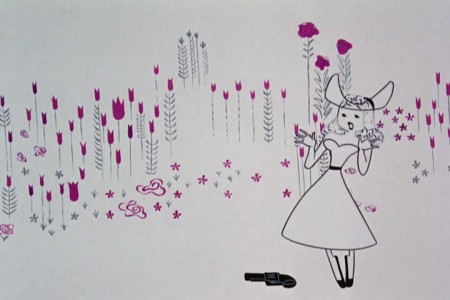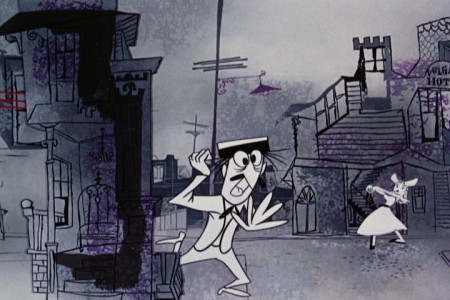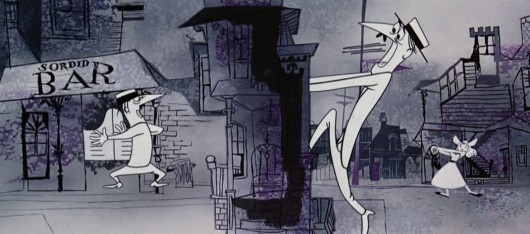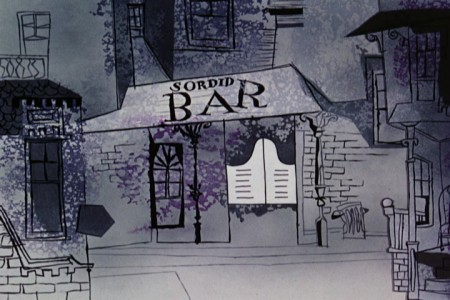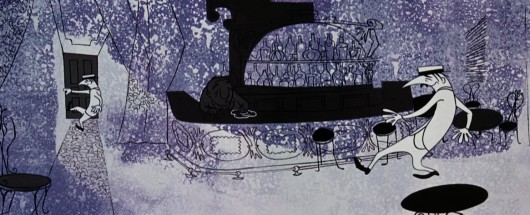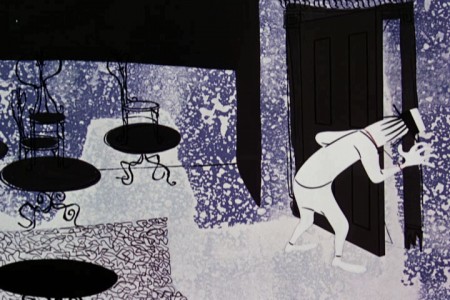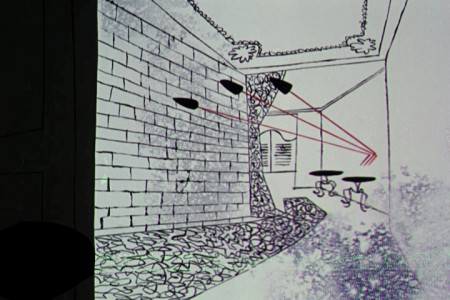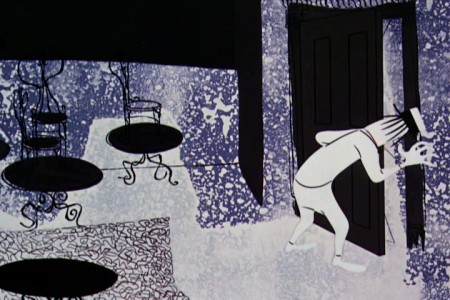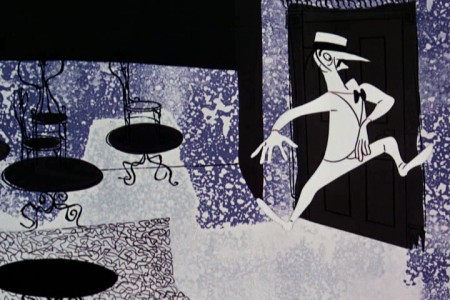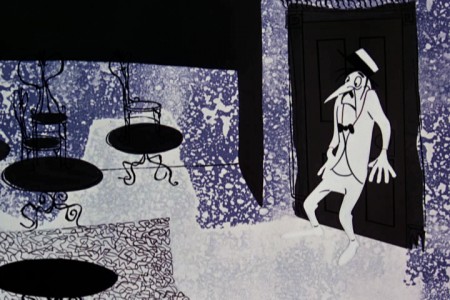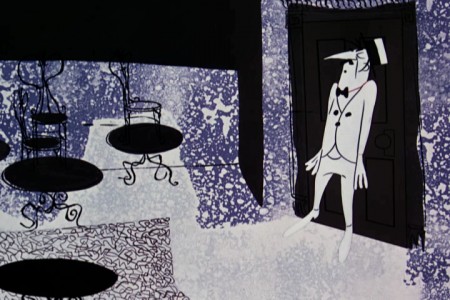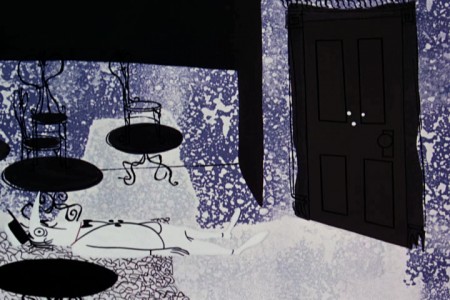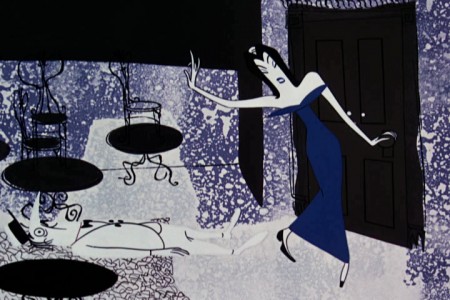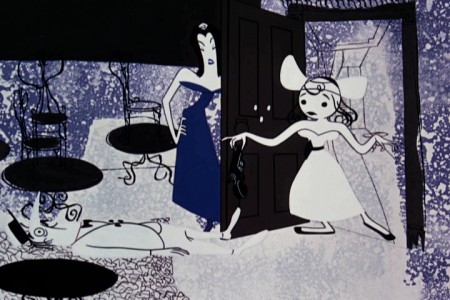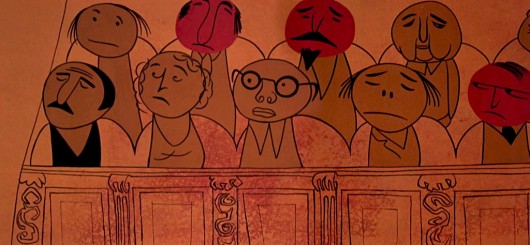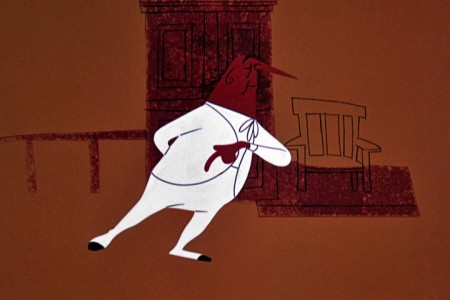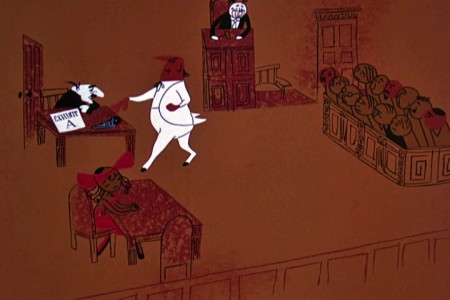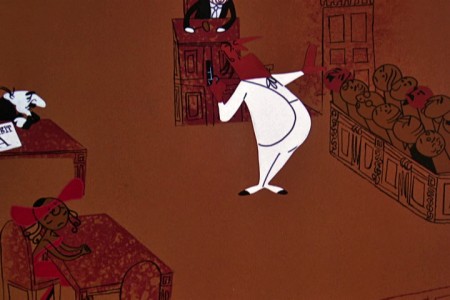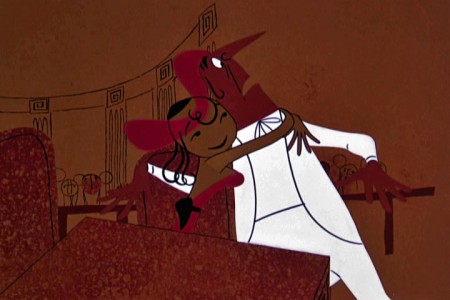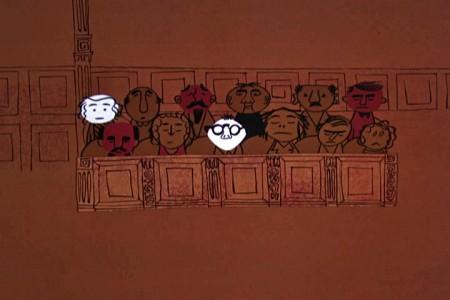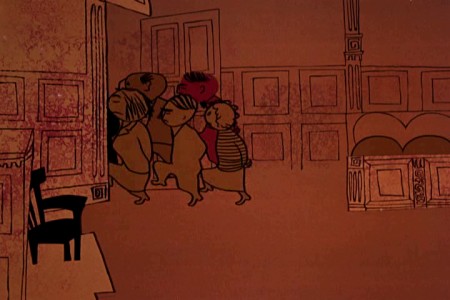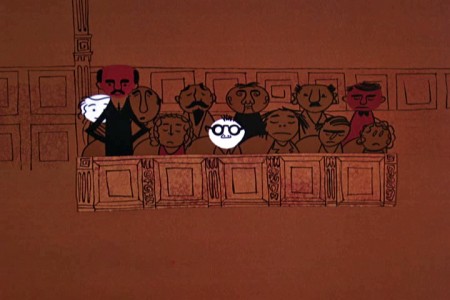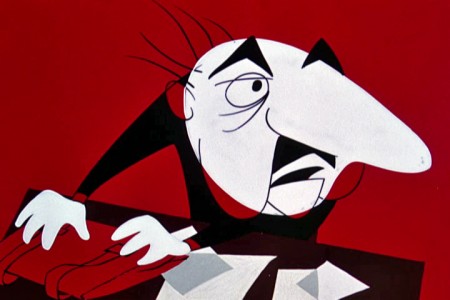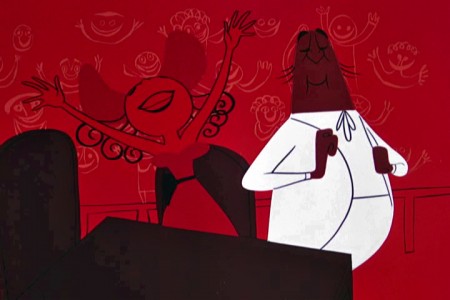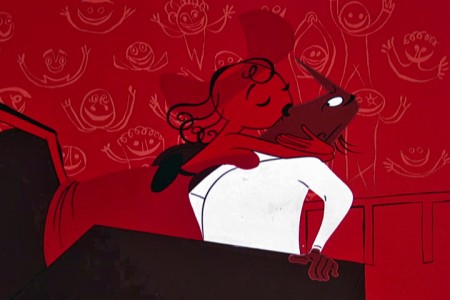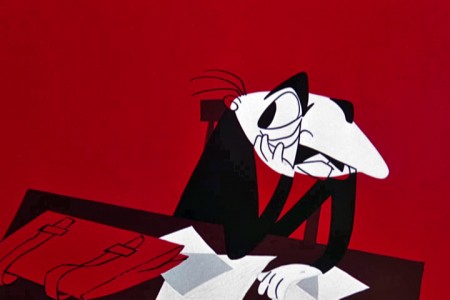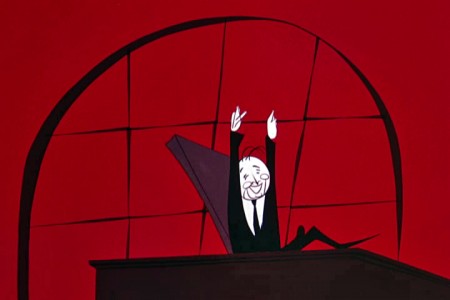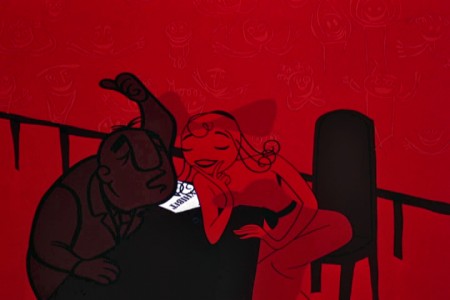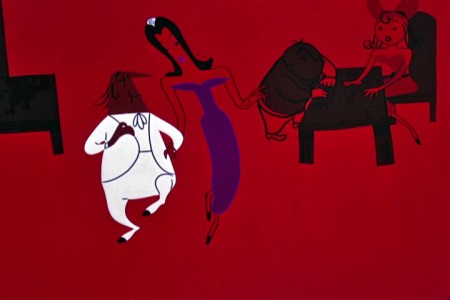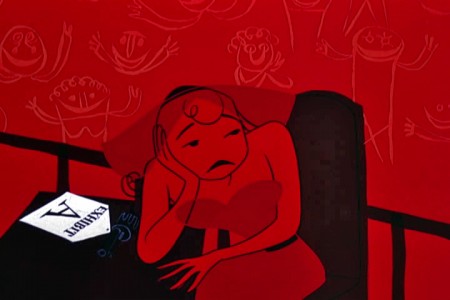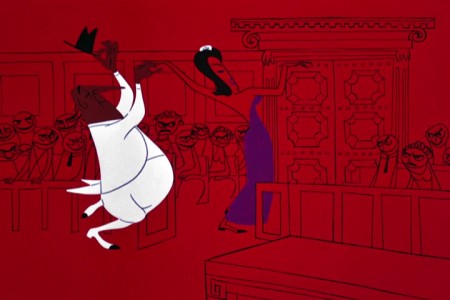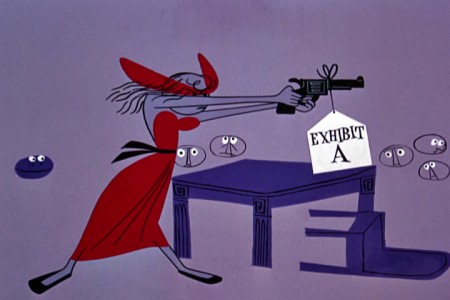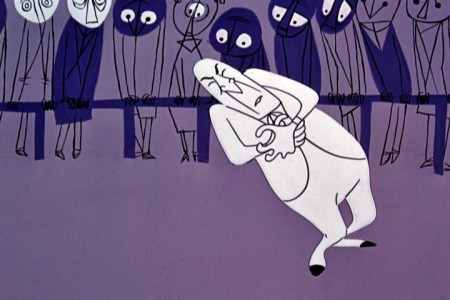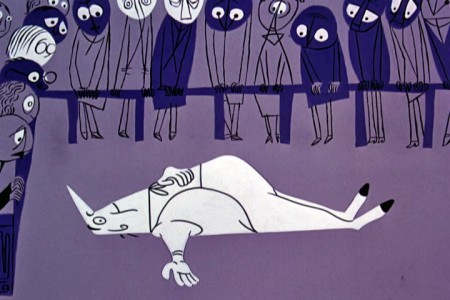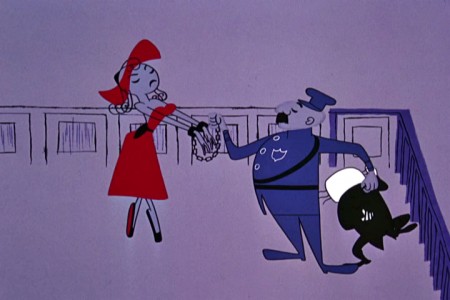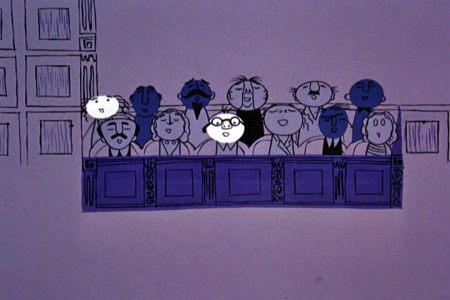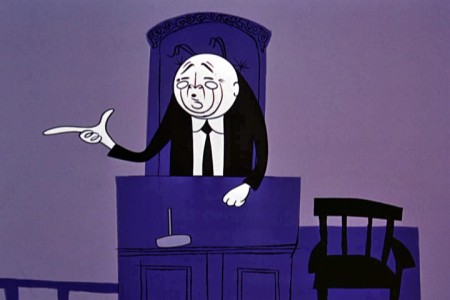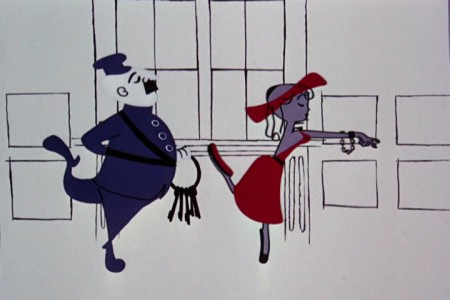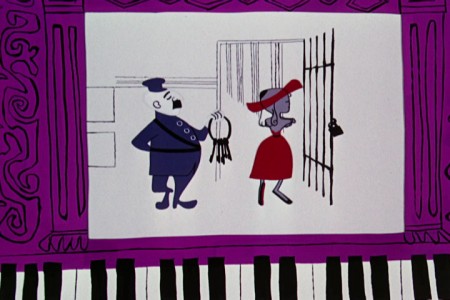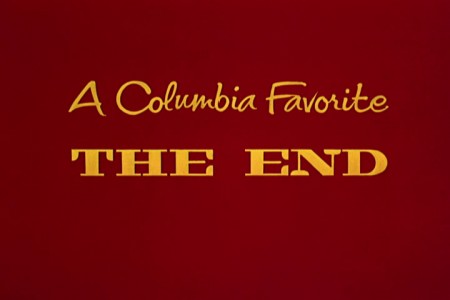Category ArchiveFrame Grabs
Animation Artifacts &Frame Grabs &Story & Storyboards 23 Jul 2012 04:33 am
Oom Pahs
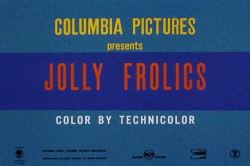
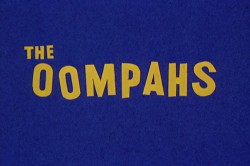
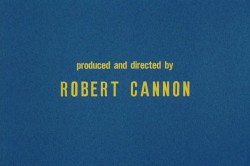 - I’m a fan of T.Hee‘s work. I bought the storyboard he did for the film The Oom Pahs a while back. How could I go wrong since I also love UPA and Bobe Cannon, who directed it. This was the first collaboration between T.Hee and Bobe Cannon.
- I’m a fan of T.Hee‘s work. I bought the storyboard he did for the film The Oom Pahs a while back. How could I go wrong since I also love UPA and Bobe Cannon, who directed it. This was the first collaboration between T.Hee and Bobe Cannon.
The short was a 1952 UPA film directed by Bobe Cannon. The film’s music score was by Ray Sherman who worked with Ben Pollack’s group, the “Pick-a-rib Boys.”
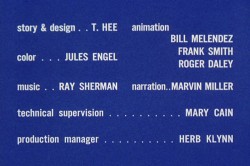 T. Hee boarded and designed the film with Jules Engel doing the bgs, and the animation was by Roger Daley, Bill Melendez and Frank Smith.
T. Hee boarded and designed the film with Jules Engel doing the bgs, and the animation was by Roger Daley, Bill Melendez and Frank Smith.
The film isn’t one of the best UPA shorts. I find the style interesting (cut out colored construction paper) but the story (which to me seems to be a variation of Warner’s I Love To Singa, which was a take on Jolson’s Jazz Singer) is a jazz vs classical music riff. The film talks down to its audience a bit – a frequent problem with many of the UPA films.
The pages I have obviously are not the whole thing nor are they consecutive in number, but they’re a good sampling.
Here are those board pages intergrated with frame grabs from the same sections of the film so you can see how closely the cutout animation followed T.Hee’s board.
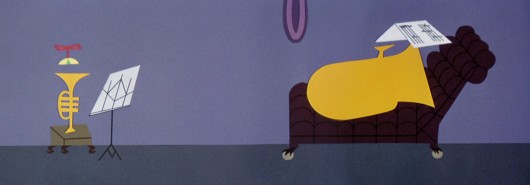
The story tells of a young trumpet in a family of horns.
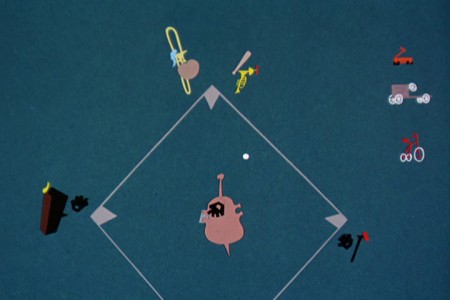
He gets in trouble playing baseball (jazz) when he should be . . .
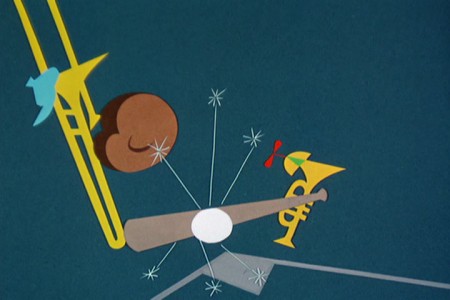
. . . practicing his classical music lessons.
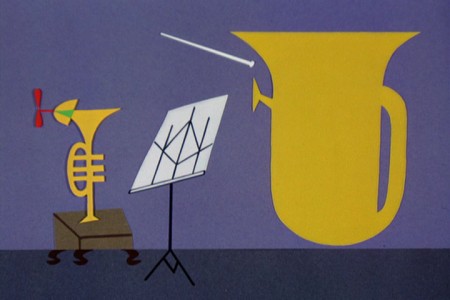
“… And he’s going to play the way I say!”
There’s no doubt the cutouts are pasted to cels.
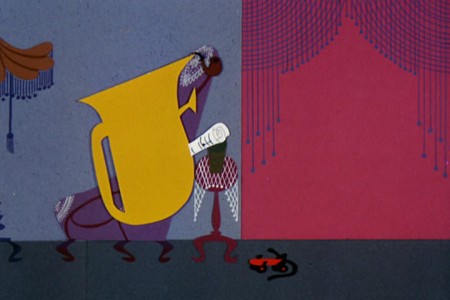
“And he marched pompously from the room.”
The animation repeats itself exactly, and it could not
have been animated under the camera, on the fly.
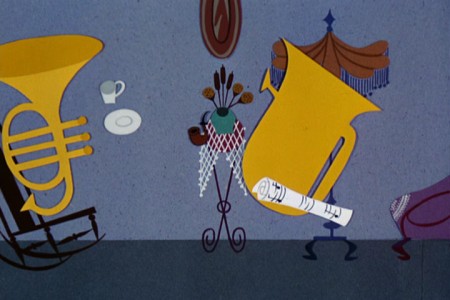
“OomMama wisely said nothing
and sipped her tea.”
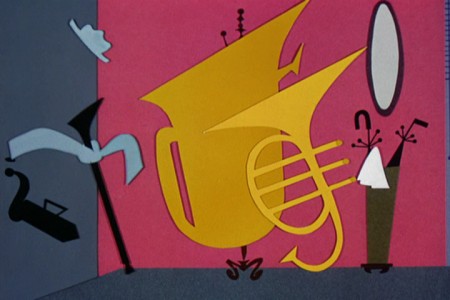
“Doc, OomMama and OomPapa drop their cups and saucers . . . ”
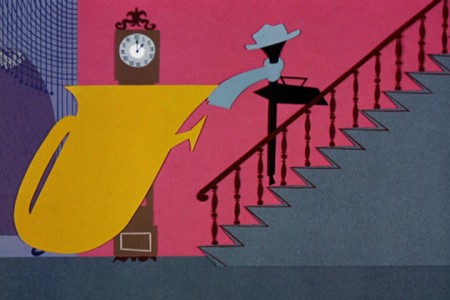
“. . . and hustle up the stairs.”
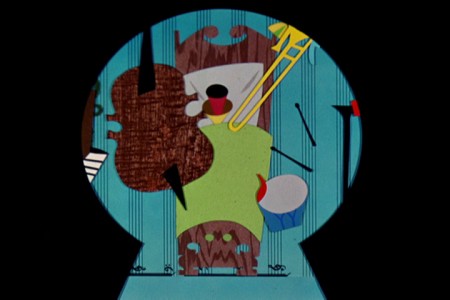
“A band without a horn just ain’t a band.”
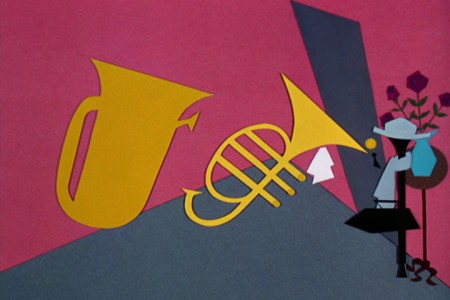
“A horn without a band is still a horn.”
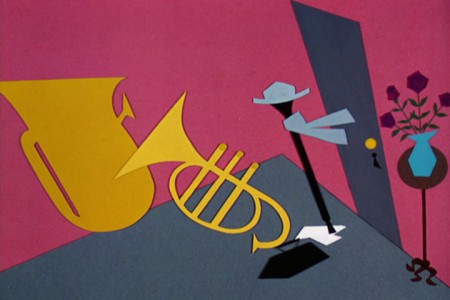
“A band without a horn sounds so forlorn.”
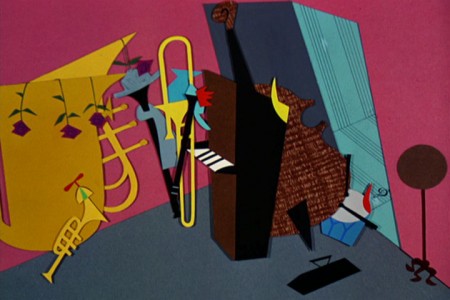
“Just gotta, just gotta, just gotta . . . ”
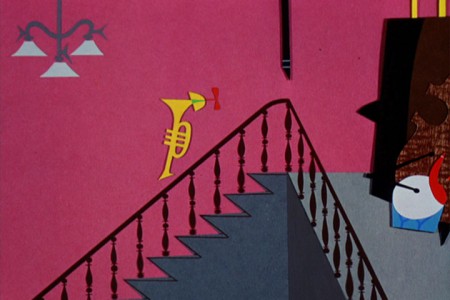
“. . . have a horn in the band.”
To see a couple of layout drawings for this short, from Hans Walther‘s collection, go to site here and here.
Disney &Frame Grabs &Models &Story & Storyboards 16 Jul 2012 05:00 am
Witch – recap
With all the reworked versions of Snow White in Live Action that are currently bombing at the box office, Disney cancelled another one that was in production. The Order Of The Seven had Soairse Ronan cast as the Snow White-like character. The story took place in Asia and had samurais.It’s not happening anymore. This is a good time to take a look at a great sequence from the wonderful original version. I originally posted this in January, 2009.
- It’s not always easy to kill a witch. This sequence from Snow White couldn’t be designed better. It’s short, it’s tense, it’s a tight sequence that handily does its job. The witch is killed in record time. Today, the sequence would be dragged out for half the length of the film.
Some of these drawings are great.
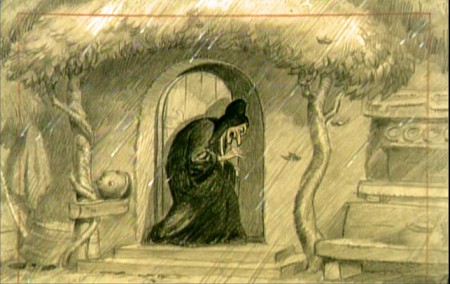 1
1(Click any image to enlarge.)
Hans Bacher continues with his beautiful background recreations, posting a number of clean backgrounds from Snow White, yesterday, on his blog. These are gorgeous and deserve your attention.
Disney &Frame Grabs &Layout & Design 12 Jul 2012 05:34 am
Neilsen’s Mermaids – recap
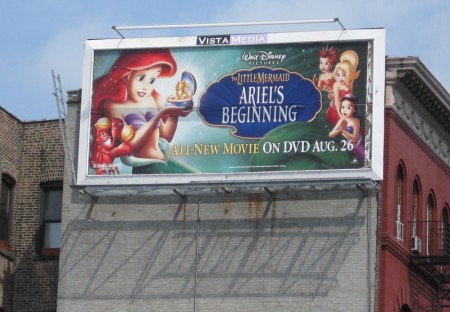
- Since the Little Mermaid sequel – no wait, it’s a prequel – just aired on Disney Jr. a few days ago, I thought this a good time to post some of Kay Neilsen ‘s illustrations done for Disney back in the 30′s when they were initially thinking of doing the Andersen tale as a film. These frame grabs come from the extras on the Platinum Edition of the dvd.
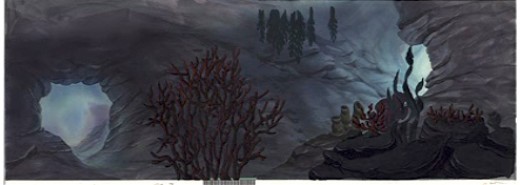
(Click any image to enlarge)
Action Analysis &Animation &Animation Artifacts &Frame Grabs &Hubley &Independent Animation &Layout & Design &Tissa David 09 Jul 2012 05:24 am
Of Men & Demons – Redux
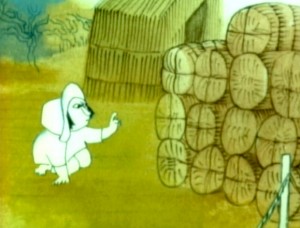 – Since first seeing the Hubley short, Of Men & Demons, back in 1967, I’ve been a fan. The artwork was stunningly different and original. It had a rich tone to it and some beautiful Hubley Bgs. The music by Quincy Jones was as original as the film, itself.
– Since first seeing the Hubley short, Of Men & Demons, back in 1967, I’ve been a fan. The artwork was stunningly different and original. It had a rich tone to it and some beautiful Hubley Bgs. The music by Quincy Jones was as original as the film, itself.
The short was actually an industrial film done for IBM to explain the binary code to its employees. The Hubleys, however, built on that story to make something of a personal film that received an Oscar nomination.
(Click any image on the page to enlarge.)
Art Babbitt was one of the first animators hired. At some point, Tissa David was brought on to rework some of Babbitt’s beautiful animation. Unfortunately, it was on about fourteen levels and had to be combined and reconstructed and shortened. (Today, of course, there are no limits to levels, but in the days of the camera you kept things to 4 cel levels, as a rule, and never more than 5.) It was complicated by the fact that John Hubley had decided to shorten the piece, and Quincy Jones’ score was shorter than Babbitt’s animation. This chore took some effort and involved dissolve animation. Tissa then continued on the sequence animating the little protagonist and his female companion through the remainder of the film.
About 25 years ago, Tissa David gave me an envelope full of art from this film, and going through a lot of my old material recently, I came upon that envelope.
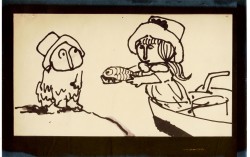 3
3 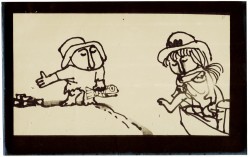 4
4
These are storyboard drawings for a short sequence. Tissa got these drawings and prepared Layouts for the sequence. You can see how much is actually in John’s drawings so it’s easy to build on what he’s given you.
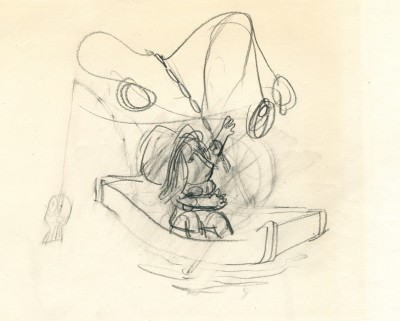 1
1The following are key drawings Tissa prepared for the sequence in laying it out.
Here is a short piece that Tissa did of the little woman character seeding her front yard. There’s so much grace in every one of these drawings and enormous information in the walk, itself.
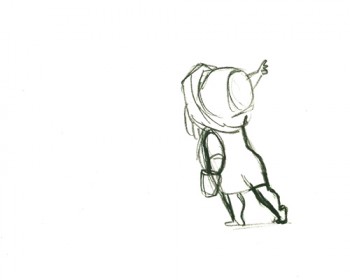 G47
G47(Click any image to enlarge to full animation sheet.)
.
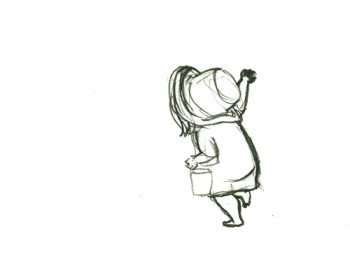 G49
G49.
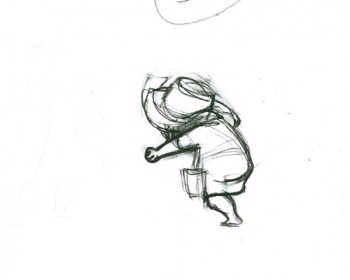 G51
G51.
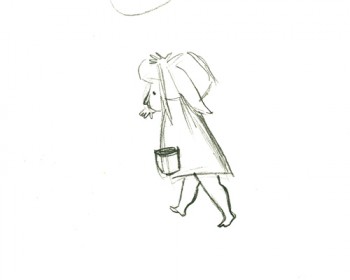 G53
G53.
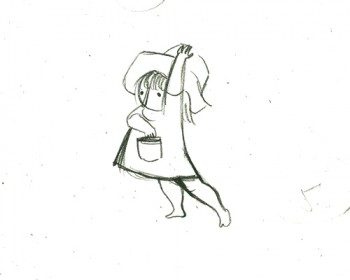 G55
G55.
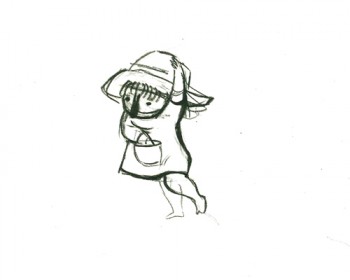 G57
G57.
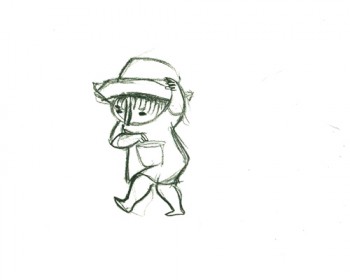 G59
G59.
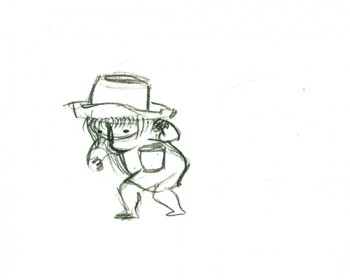 G61
G61.
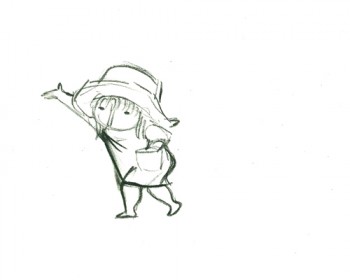 G63
G63.
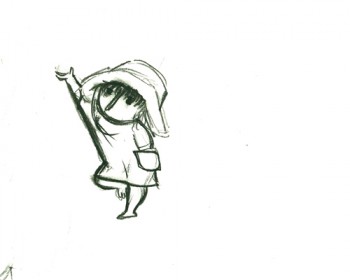 G65
G65.
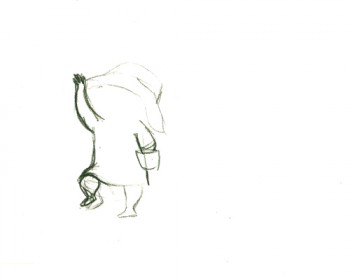 G67
G67.
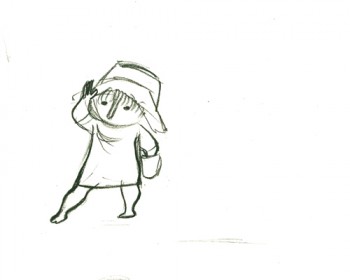 G69
G69
And here are the matching frame grabs from the film.
Seeding crops PT & Final Color
Frame Grabs &Hubley &UPA 18 Jun 2012 06:40 am
The Four Poster – part 4
- This is the fourth part of the animated segments from the live feature, The Four Poster, with animated segments from UPA directed by John Hubley with animation directed by Art Babbitt and design supervised by Paul Julian.
As I wrote with each of the past posts, the film is an adaptation of the play by Jan de Hartog which takes place wholly in one room – the bedroom – around a fourposter bed. We see scenes wherein the couple marries young and grows old together. The only time we stray from the room, in the film, we do it via the enormously creative UPA animation. The film starred real husband and wife, Rex Harrison and Lilli Palmer.
This sequence represents an attempt for the couple to come together again after a difficult period. They take a vacation to Paris, France.
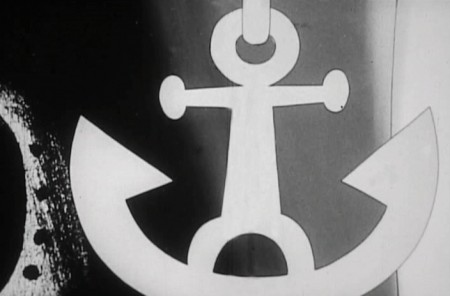 1
1Cut to an anchor being lifted.
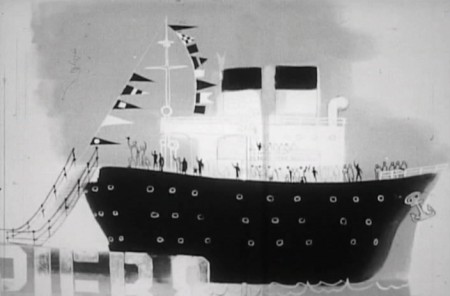 2
2
The cruise ship is set to take off.
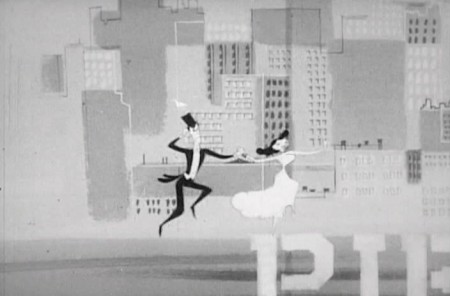 3
3
Our couple races to the ship, they’re late.
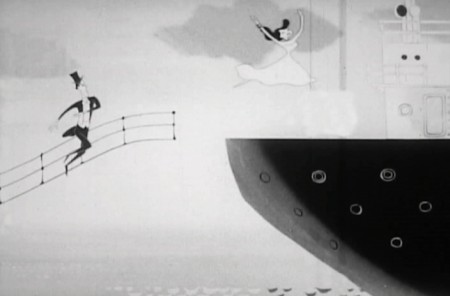 5
5
As the ship pulls away she jumps on board.
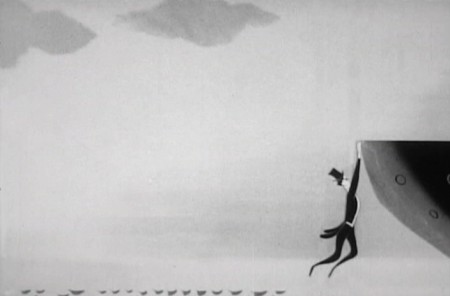 6
6
He tries and misses, hanging at the edge.
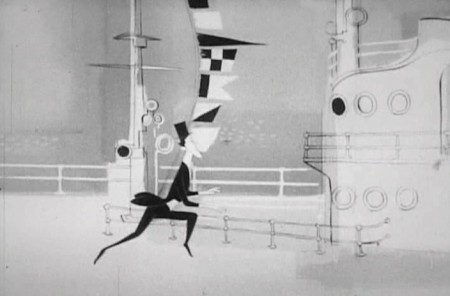 7
7
He lifts himself on board . . .

. . . but has to search for his wife.
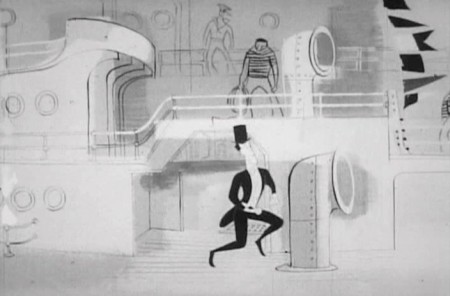 11
11
He continues to dance in search of his wife.
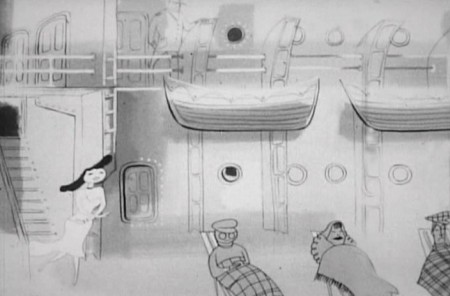 12
12
She’s just a bit forward of him.
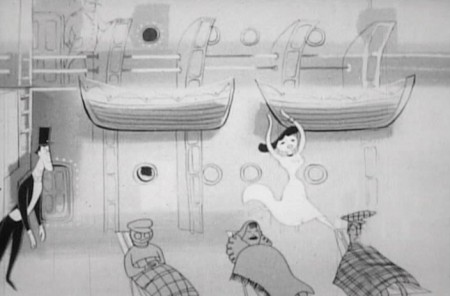 13
13
She dances over some resting passengers.
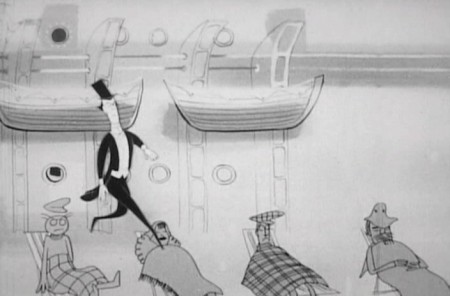 14
14
He tries to do the same, but ends up . . .
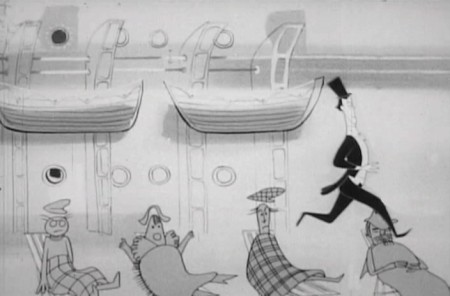 15
15
. . . stepping on each of the people in deck chairs.
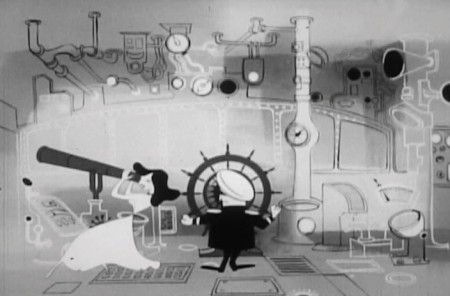 16
16
She’s in the captain’s chair looking through a telescope.
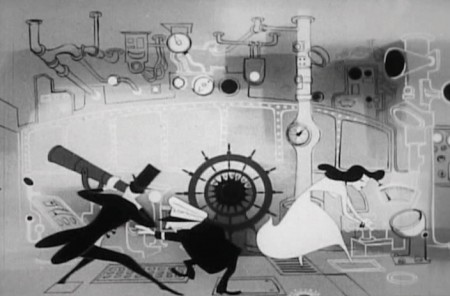 17
17
He joins her to see what she’s been looking at.
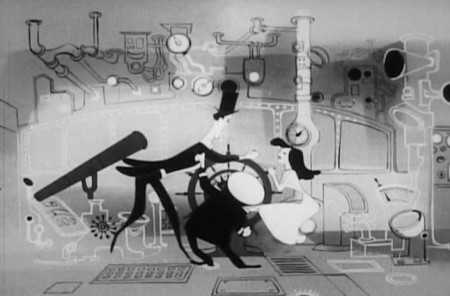 18
18
The two of them scrabble over the steering wheel.
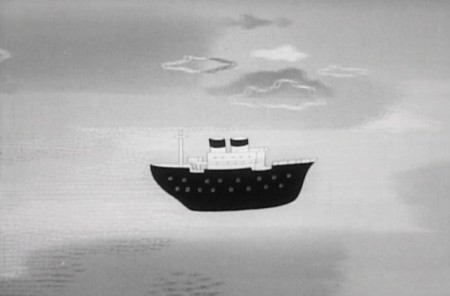 19
19
The ship spins about at sea.
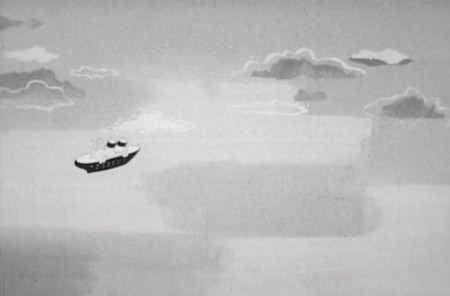 21
21
It goes spinning into the horizon.
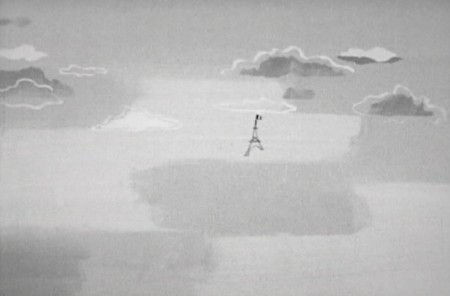 22
22
The Eiffel Tower dances forward.
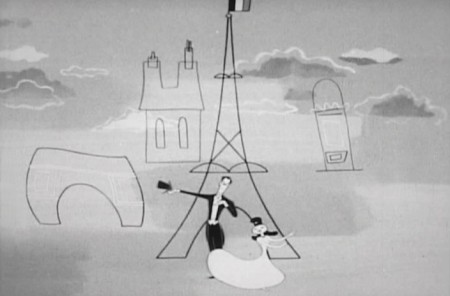 24
24
They finally join in front of the landmark.
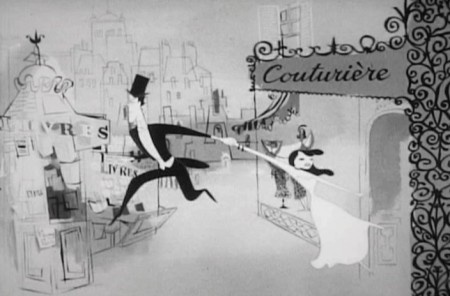 26
26
He tries to pull her away from a Couturier (dress maker).
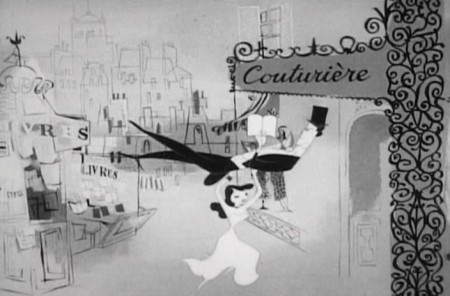 27
27
She ends up literally carrying him into it.
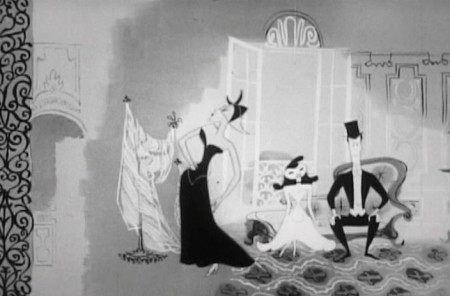 29
29
He’s seated on a devon to watch the fashion show.
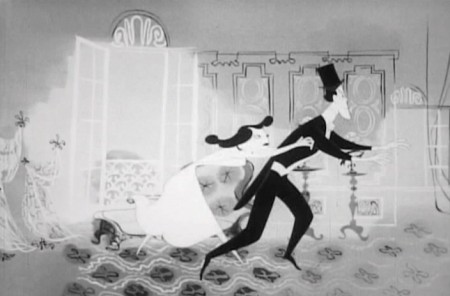 30
30
Finally, he pulls her further in . . .
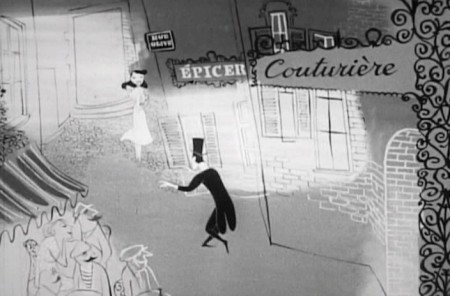 31
31
. . . and she leads him outside.
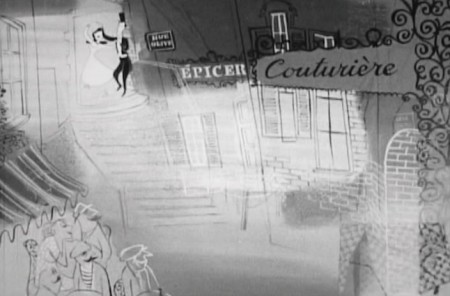 32
32
They pause at the top of a stairway.
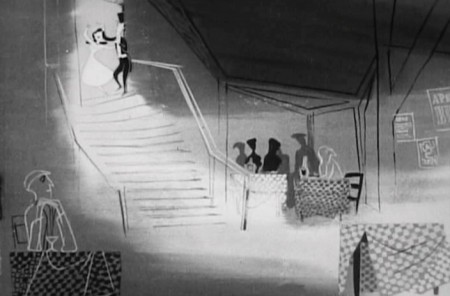 33
33
The background dissolves to a cabaret.
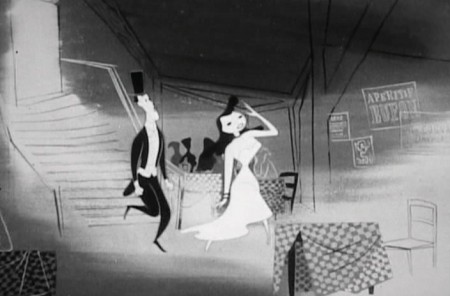 34
34
The couple enters and seats themselves at a table.
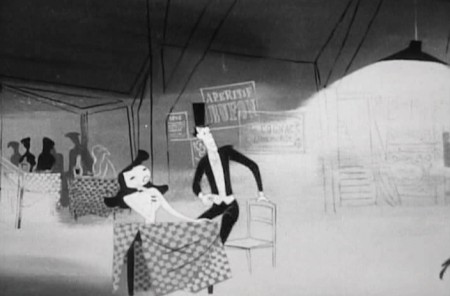 35
35
There’s no doubt that Art Babbitt animated this “Apache Dance.”
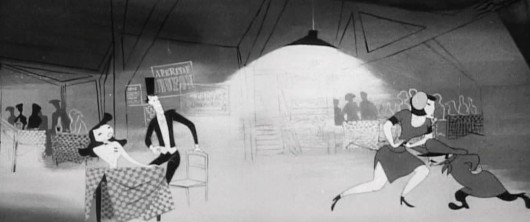
Pan across as an “Apache Dance” is in progress as the floor show.
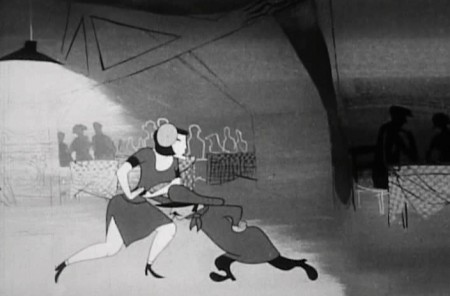 37
37
The male pushes the female back toward the couple’s table.
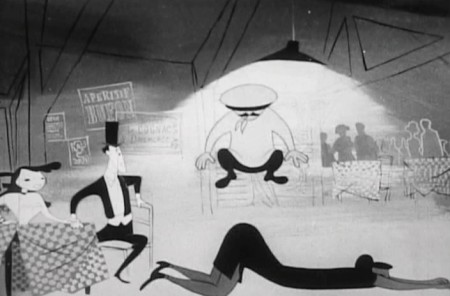 38
38
He jumps on top of her, in rhythm to the music.
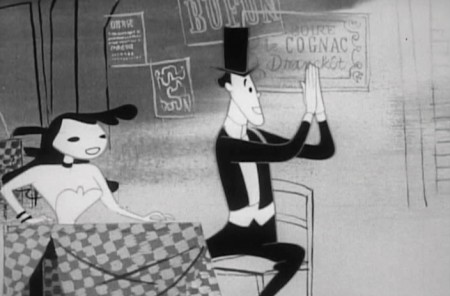 39
39
2 shot – He applauds the dance.
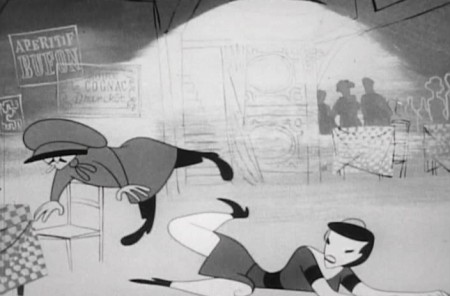 40
40
She knocks the male dancer off his feet.
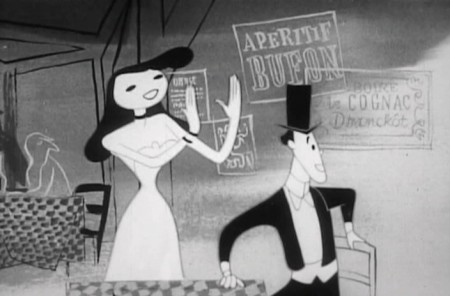 41
41
2 shot – she applauds the female.
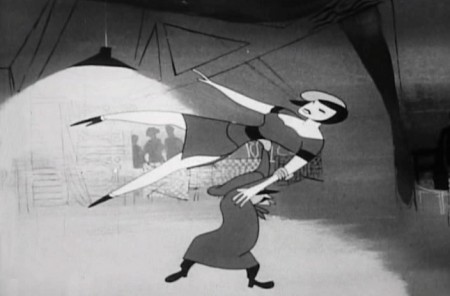 42
42
The guy lift the female over his head
and off the screen.
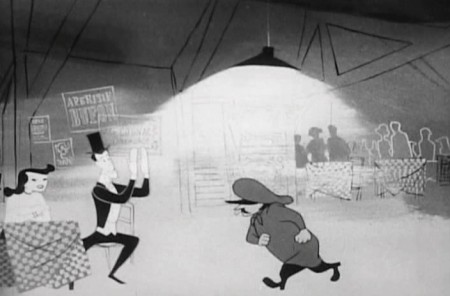 43
43
He then goes to our male and . . .
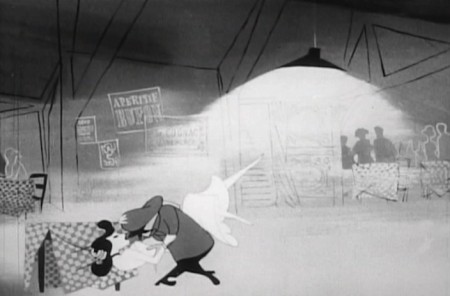 45
45
The male then dances with her.
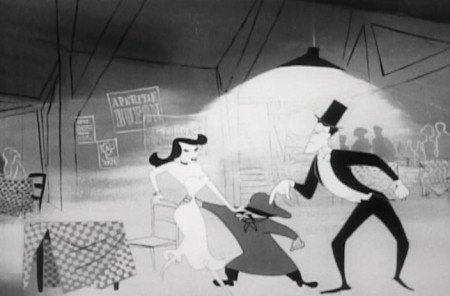 46
46
Our hero enters, and taps the dancer on the shoulder,
as if it’s his turn to cut in to the dance.
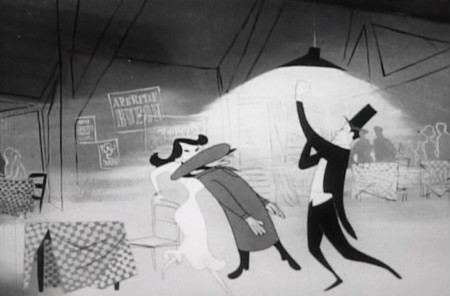 47
47
Instead, he knocks out the male dancer.
All to the rhythm of the song.
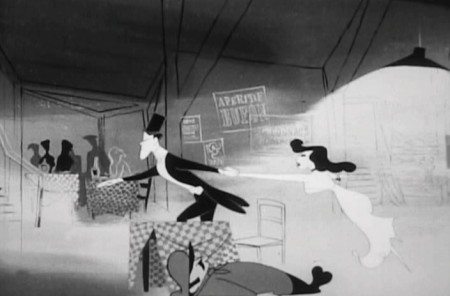 48
48
Our couple dances toward the door.
Exit Paris.

. . . and the camera pans back . . .
The final sequence begins with the couple elderly and close.
It becomes obvious that she dies as we move to him writing at his desk.
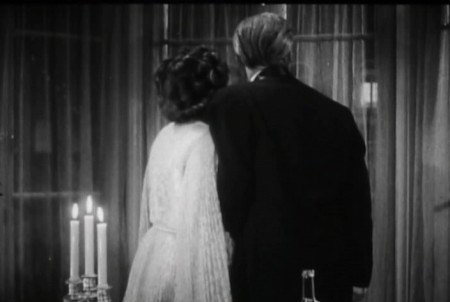 1
1
We see a beautiful Paul Julian painted sequence which shows
their house as it grows old in a series of dissolves.
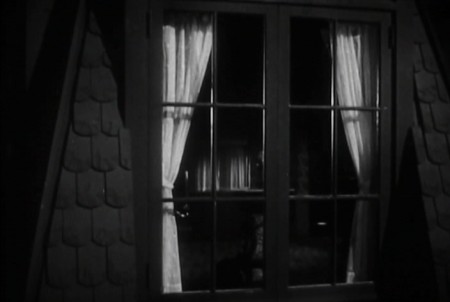 12
12
Back in through the Live Action window.
We see him with his head at rest on his desk.
It seems obvious to me, after all the time I’ve recently spent studying the UPA Å“uvre, that there were a lot of forward thinking individuals who were quite adept at creating modern designs, quite like new textiles or illustrations. However, it would seem to me that only a small few were actually artists. John Hubley and Paul Julian were certainly in this latter character. Hubley was incapable of drawing a cartoon, and Julian was painting his backgrounds in the same, serious style as his own Art. Together, they were brilliant. It’s only unfortunate that they didn’t have the assist of animation by Bobe Cannon. He is one who took the animator’s job to a higher order. We’d have to wait a decade to see Hubley and Cannon together, but, by then, Julian wasn’t available to them, and Hubley painted his own Backgrounds. See Adventures of an * or Tender Game, and try to see one of the stunning, newly reconstructed prints from MoMA.
Frame Grabs &Hubley &UPA 11 Jun 2012 07:01 am
The Four Poster – part 3
- I’ve located a better copy of The Four Poster, so my posts will be more in focus henceforth. I’ve gone back and replaced the images in Part 1 and will do the same for Part 2 in the next week.
The Four Poster, in case I have to remind you, is a live action feature adaptation of a play by Jan de Hartog. It was produced by Stanley Kramer and directed by Irving Reis. The film takes place entirely within the bedroom of a married couple as they grow old together. To open up the film, they turned to animation working with the Columbia studio, UPA. John Hubley supervised all of the animation following his recently completed film, Rooty Toot Toot.
Part 3 starts as the couple’s child has grown up and gone off to War. World War I. The sequence was supervised by Paul Julian, and like most of his other directorial efforts it’s about beautiful paintings and graphic movement.
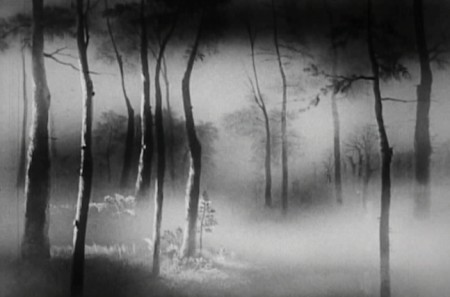 1
1
_______________________________
From the death of their son, the film takes us forward into the Roaring Twenties.
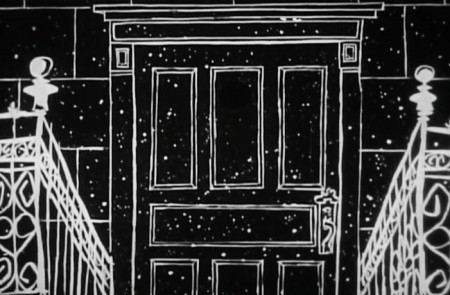 1
1
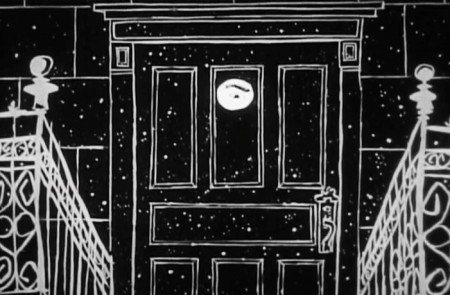 2
2
It’s a world of speakeasies.
Frame Grabs &Hubley &UPA 04 Jun 2012 06:54 am
The Four Poster – part 2
I’ve recently purchased what, I think, is a much better copy of this film. When it arrives, I’ll replace this and the last post with better images and continue on from there. In the meantime, I’ve done this post.
- Last week we bit into the UPA animated sequences from The Four Poster. These were directed by John Hubley, with Paul Julian credited as designer and Art Babbitt and Lew Keller credited as animators. Of course, more people were involved in that they broke the film up into segments with different teams doing individual segments.
The animation, naturally is in B&W (to match the live action film they were designed to interecede.) The boring live action film is an unimaginative adaptation of the Broadway play by Jan de Hartog. It became a travelling show that was often performed by husband and wife teams. In fact this film stars a husband and wife: Rex Harrison and Lilli Palmer. It was produced by Stanley Kramer and directed by Irving Reis. Kramer, who was very political in his film making (High Noon, Guess Who’s Coming to Dinner, Judgement at Nuremberg) no doubt stayed away from the set rather than deal with the volatile actors on the set. He had an easier time of it hiring the animation studio; he just stayed on the Columbia lot.
The film never strays from the bedroom of this couple, and we get the life story of the couple from the vantage point of the bedroom, which features the titular fourposter bed. Quite claustrophobic. They expand on it using the animation, and one almost wishes they had done the entire film in animation. It was later adapted into a musical called, I DO, I DO, and starred Robert Preston and Mary Martin on Broadway. It was written by Tom Jones and Harvey Schmidt (who also wrote THE FANTASTICKS.) That’s a much better show; the songs make it tolerable.
Here are frame grabs from the next two sequences: 3 & 4.
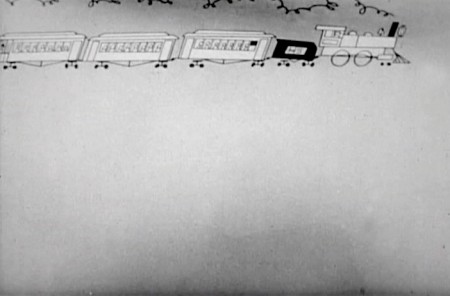 1
1A train enters and the camera moves in on it.

A pan (right to left) shows a lot of women reading
books by our lead character John Edwards (Rex Harrison).
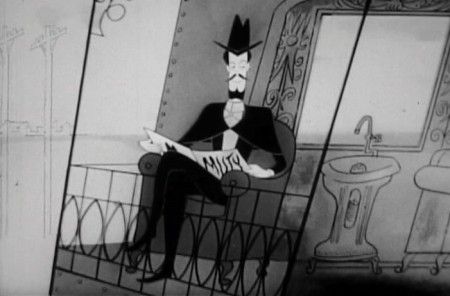 4
4
The pan ends on Edwards seeing
the full car of women staring at him.
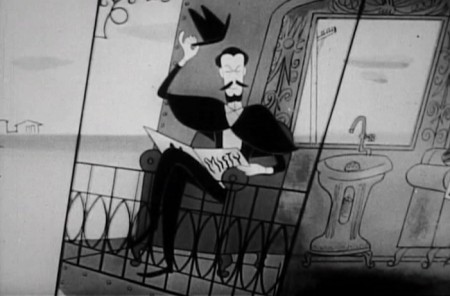 6
6
He acknowledges them as . . .
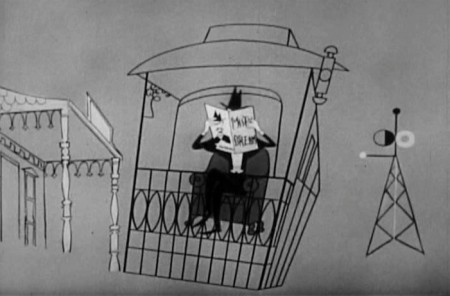 7a
7a
. . . the train moves on, and . . .
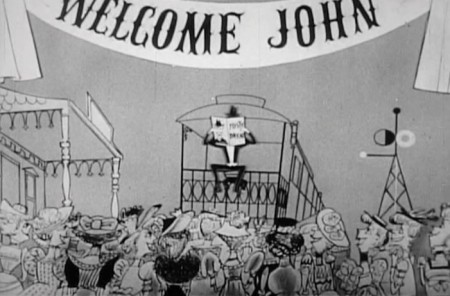 7b
7b
. . .there’s a slow transition . . .
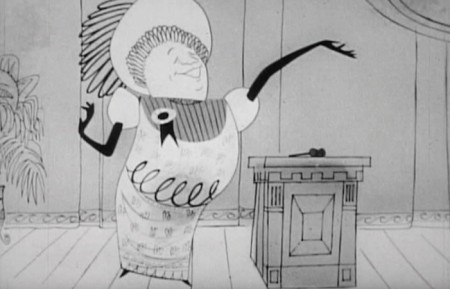 10
10
A woman speaker introduces him.
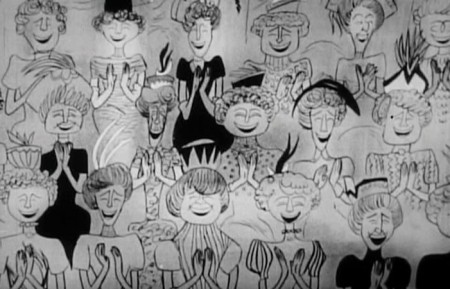 11
11
The female audience applauds enthusiastically.
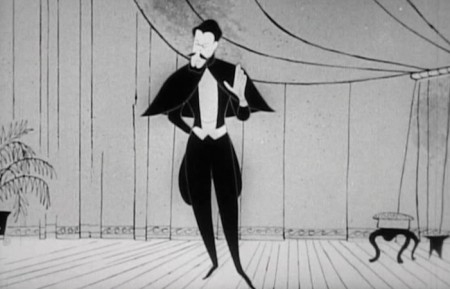 12
12
He stands to speak and . . .
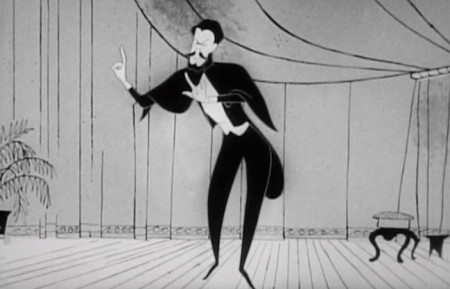 13
13
. . . gives his speech in mime. We don’t hear his words.
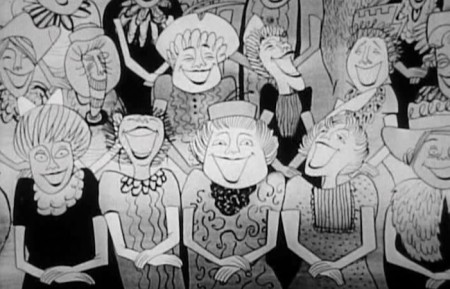 14
14
The woman laugh enthusiastically at his joke.
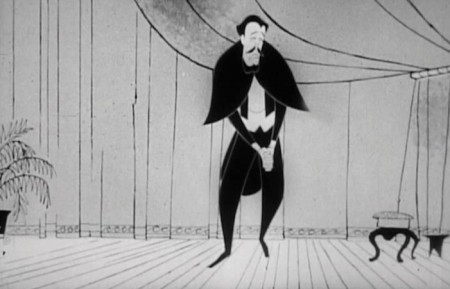 16
16
I can only wonder whether this had any influence
on Hubley’s later film, Zuckerkandl.
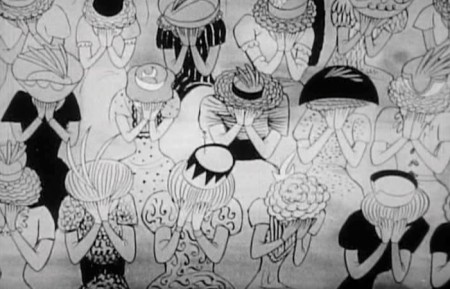 18
18
The women are in hands. They’re crying.
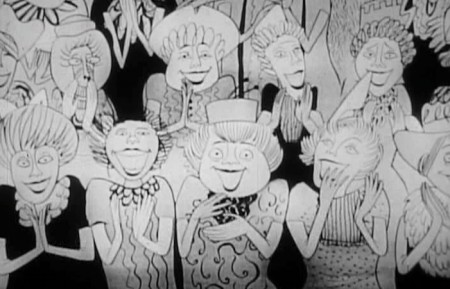 22
22
They audience is overwhelmed.
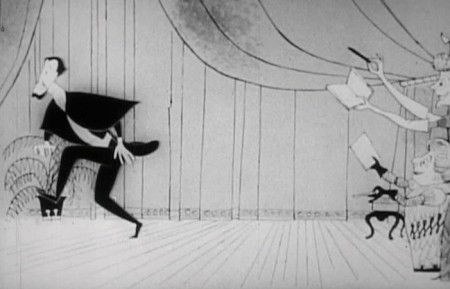 24
24
He’s chased from the stage.
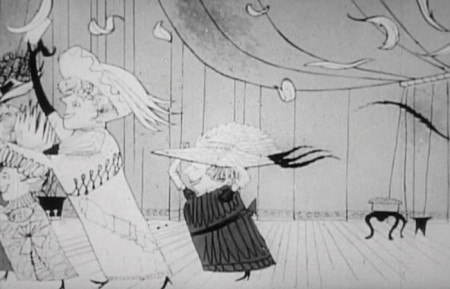 26
26
They rush him leaving feathers flying from their hats.
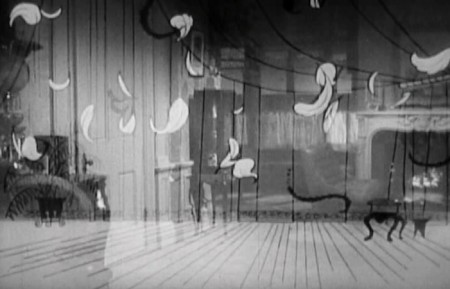 27
27
There’s a transition back to the live action bedroom.
.
__________________________
The fourth section is designed only to show us that time has passed and the city is growing up around their ears. They remain in the same house the went to after first getting married (obviously, or the film’s title would be pointless.)
.
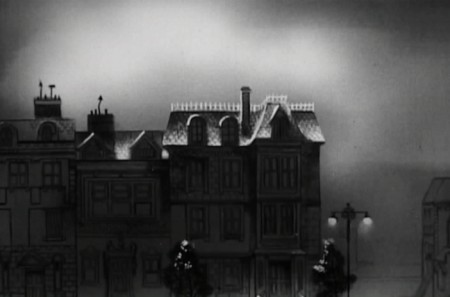 1
1

As we pan from left to right, the city builds up for the camera.
The bridge, on the far right, is the last structure to be constructed.
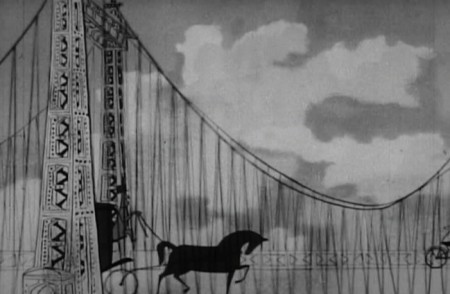 8
8
Cut in to the bridge as a horse drawn carriage enters . . .
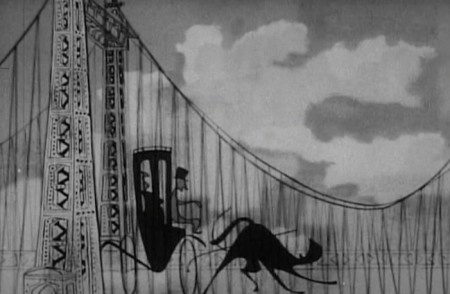 9
9
. . . and before our eyes , , ,
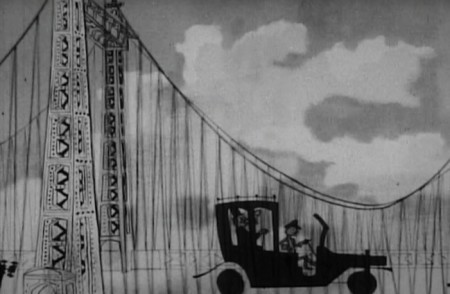 10
10
. . . turns into an automobile.
Animation Artifacts &Frame Grabs &Hubley &UPA 28 May 2012 06:21 am
The Four Poster
- One of the real neglects in animation history is the availability of The Four Poster in VHS, DVD or any other format. For some reason, this title has eluded marketers who’d want to cash in on the name of Rex Harrison or his wife, Lilli Palmer. Where’s TCM when you need them.
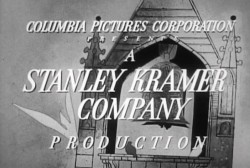 This film was a Stanley Kramer production directed by Irving Reis in 1952 of a play by Jan de Hartog. It tells the life story of a marriage between the husband and his wife. In fact, the film is so insular that it never leaves the bedroom, and it revolves around the “four poster” bed in that room. For the film, they chose to open it up by leaving the bedroom via animated inserts done by John Hubley at UPA. There are some 20 minutes of the film done by Hubley/UPA, and it’s extraordinarily progressive animation for the time.
This film was a Stanley Kramer production directed by Irving Reis in 1952 of a play by Jan de Hartog. It tells the life story of a marriage between the husband and his wife. In fact, the film is so insular that it never leaves the bedroom, and it revolves around the “four poster” bed in that room. For the film, they chose to open it up by leaving the bedroom via animated inserts done by John Hubley at UPA. There are some 20 minutes of the film done by Hubley/UPA, and it’s extraordinarily progressive animation for the time.
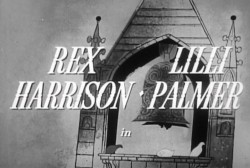 I own a good 16mm copy of the whole film, and cut the animation segments separate from the feature, I allowed a friend to make a video copy but was very disappointed with the results – out of focus and almost unwatchable. In the past couple of weeks, another friend led me to a second DVD copy which is also out of focus but not as bad as the first.
I own a good 16mm copy of the whole film, and cut the animation segments separate from the feature, I allowed a friend to make a video copy but was very disappointed with the results – out of focus and almost unwatchable. In the past couple of weeks, another friend led me to a second DVD copy which is also out of focus but not as bad as the first.
I’ve wanted to focus on this film for some time, hence I decided not to wait any longer and am sharing frame grabs with you of this muddy, soft focus version. You can still get the idea. If another, better copy turns up in the future, I’ll rework these images and repost it.
Here are bits from the opening credits. Lots of traveling right and then left and then right again.
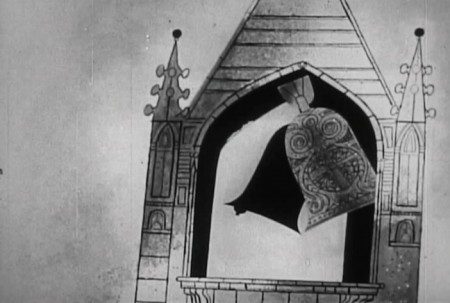 3
3The film does get very claustrophobic staying in the one bedroom set
for the entire film, with just the two characters, husband & wife, to talk
us through most of the movie. It’s exhausting.
This makes the animation more welcome than it would ordinarily be.
You’re dying for any excuse to change scenery and move the story forward.
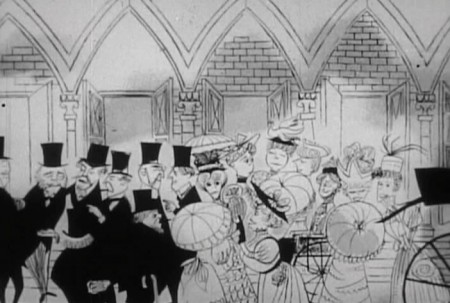 4
4
On top of this, the live action is very theatrical
whereas the animation is full of life and quite lyrical.
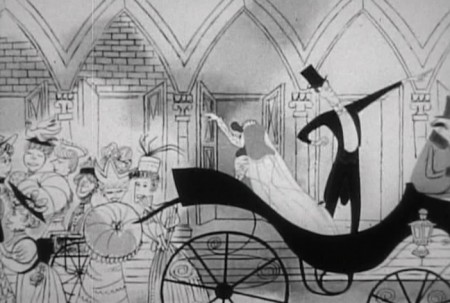 5
5
The animation does reveal a good part of the story from the
birth of their boy to his death in WWI on the front lines.
(Hubley designs one of his greatest sequences for this one.)
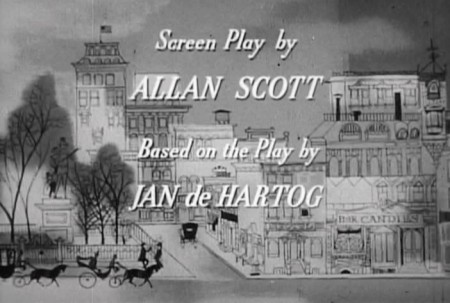 8
8
Supposedly, the film was sent to Yugoslavia for a run.
Some of the people in Zagreb were able to kidnap the film
and hold onto it for a number of additional weeks. They
studied it closely and copied it.
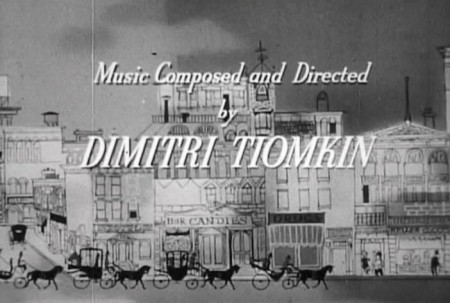 9
9
When they were finished the print was returned to
the States, and they started up Zagreb animation with their
new-found knowledge and inspiration. A bit more than inspired,
shall we say. How very 21st Century of them
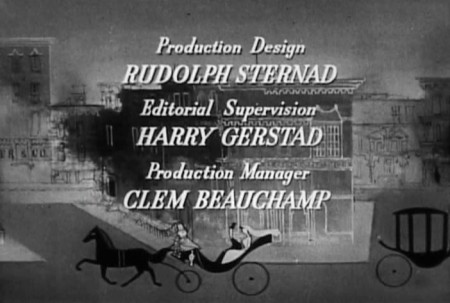 12
12
In his book, When Magoo Flew, Adam Abraham doesn’t give a lot of
space to the work on this feature. However, every small comment
seems valuable since so little has been written about this film.
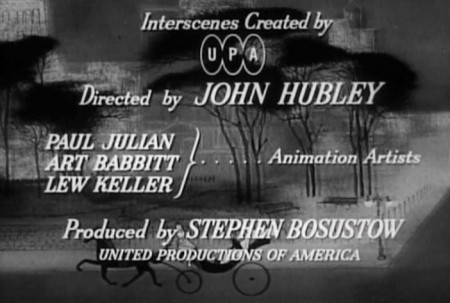 13
13
Abraham says that Hubley and crew went onto this directly after
finishing Rooty Toot Toot. They were broken into small groups
with each group doing one of the interecenes in the feature.
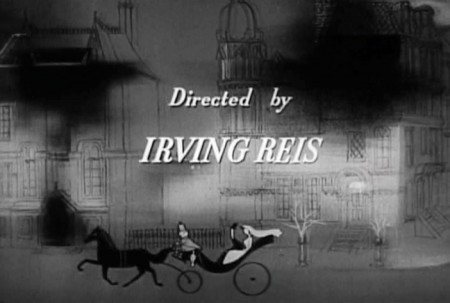 15
15
Paul Julian oversaw the stylistic representation of the War
and Art Babbitt animated the sequence showing the effect
of the war on the soldiers coming home.
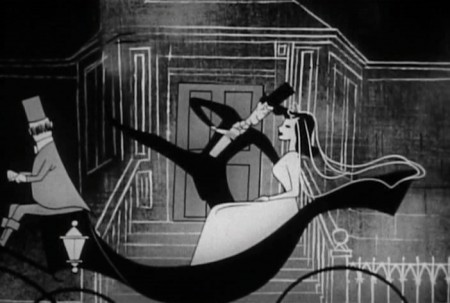 16
16
In total, it’s an enormous accomplishment.
____________________
.
The first animated intersection shows the Rex Harrison character going off to work as a teacher in a boys’ school.
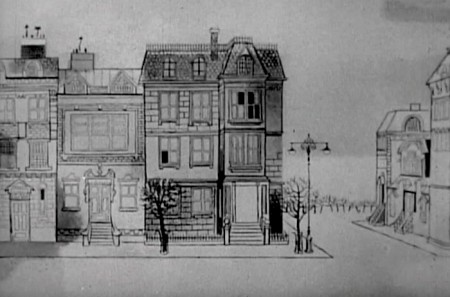 1
1
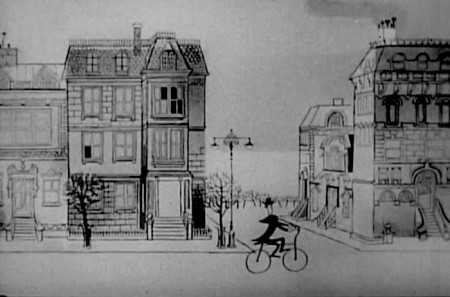 2
2
Out of the home, Rex Harrison’s character
comes cycling on his way . . .

. . . to school. Like many other sequences in this animation,
he rides a long pan to the school where he enters on bike.

Inside the school, we echo the first scene with another pan.
This time we pan from class to class ending with . . .
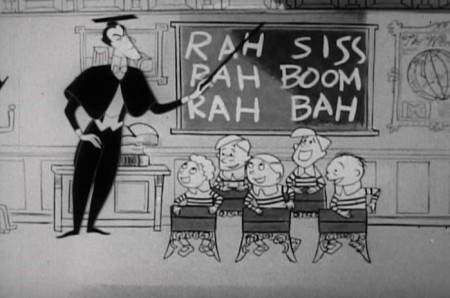 5
5
. . . Rex Harrison’s very unethical class, where the kids are having fun.
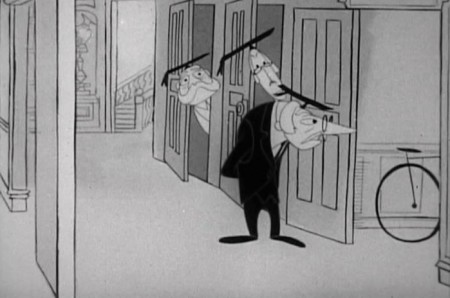 8
8
The raucus noise of his class is disturbing other teachers.
They don’t like the students having fun.
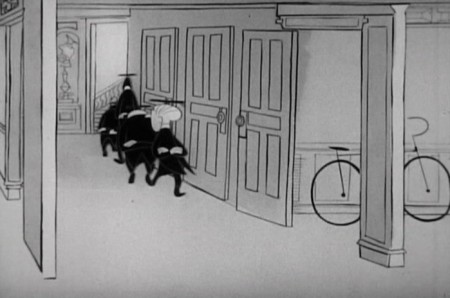 11
11
Off to the Dean’s office to complain.
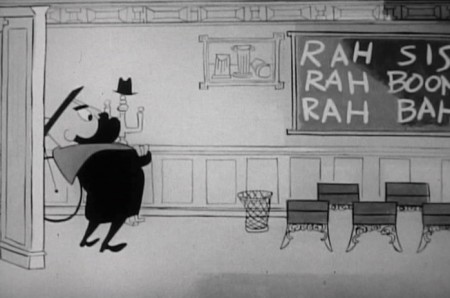 16
16
The Dean breaks in to something too much fun.
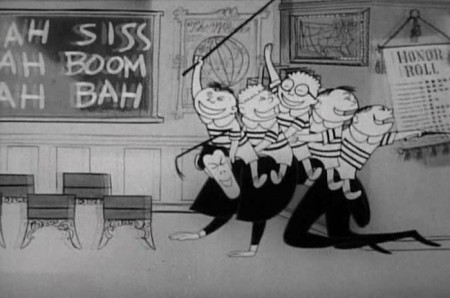 17
17
Even with the soft focus, you can see
that the character design is great.
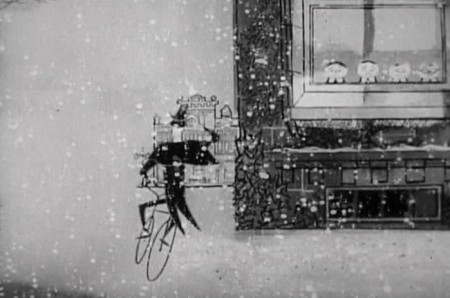 20
20
He goes off into the sunset of a
snow fall.
Back to live action
Animation &Animation Artifacts &Frame Grabs &UPA 22 May 2012 06:55 am
Nelly Bly’s Twisted Arms
This is one of my favorite scenes of all time. Nelly Bly is on the witness stand, and she’s constantly straightening herself out as she gets deeper and deeper into her side of the story. Grim Natwick’s animation is perfect, and John Hubley’s direction and design is even better. The judge, behind her, couldn’t be better positioned.
This is a great cartoon, possibly UPA’s best. It lost the Oscar to The Two Mousketeers, a Tom and Jerry cartoon, and not even a particularly good Tom and Jerry cartoon. It would take another ten years before AMPAS ruled that you had to see the short films to be able to vote on them.
I tried to include this scene with its soundtrack, but it took longer than I could afford to give it.
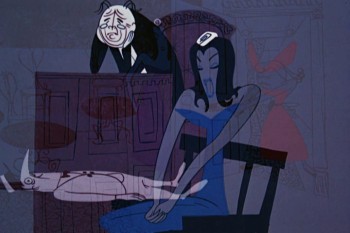 01
01
______________________
The bump in the middle is a hold wherein there’s a
camera move. I replaced it with a short dissolve.
Frame Grabs &Hubley &UPA 21 May 2012 05:15 am
Rooty Toot Toot
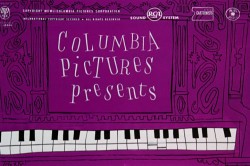 - As you know, I like this cartoon. Rooty Toot Toot. I think it’s one of the very best animated films ever made. The film combines brilliant design, with great animation, and an extraordinary story.
- As you know, I like this cartoon. Rooty Toot Toot. I think it’s one of the very best animated films ever made. The film combines brilliant design, with great animation, and an extraordinary story.
Kurosawa had directed Roshomon in 1950, and it had just touched down in the US. This tells of several people who meet up while waiting out a rain storm as they tell their differing versions of the killing of a samurai. It 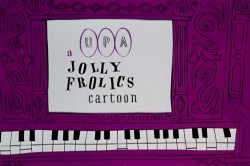 takes place in 12th Century Japan. There is no doubt that Hubley saw this film and does his cartoon adaptation of Frankie & Johnny using the same schema. It was not only daring for animation, but it was daring for film. It took the hands and eyes of a master to pull it off, and Hubley succeeded in the short 8 min cartoon.
takes place in 12th Century Japan. There is no doubt that Hubley saw this film and does his cartoon adaptation of Frankie & Johnny using the same schema. It was not only daring for animation, but it was daring for film. It took the hands and eyes of a master to pull it off, and Hubley succeeded in the short 8 min cartoon.
There is the legend that Steve Bosustow tried to get Hubley to speed up the
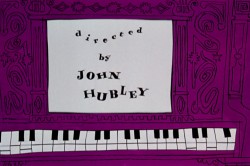 storyboard/writing process where finally the director had to lock himself and the board in to keep the production on hold until he thought it was finished. Eventually, according to the story, Bosustow broke down the door and put the film into its next phase. I don’t know what truth is in this, but I assume there must be a little something to it.
storyboard/writing process where finally the director had to lock himself and the board in to keep the production on hold until he thought it was finished. Eventually, according to the story, Bosustow broke down the door and put the film into its next phase. I don’t know what truth is in this, but I assume there must be a little something to it.
Unlike most other UPA films, this movie was made for an adult audience and it had no
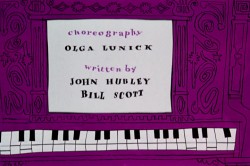 children to speak down to. Unlike most other UPA films, the art style came from 20th century art, not “illustration.” The inspiration was more Steinberg, Ben Shahn and WPA than Vanity Fair or the New Yorker.
children to speak down to. Unlike most other UPA films, the art style came from 20th century art, not “illustration.” The inspiration was more Steinberg, Ben Shahn and WPA than Vanity Fair or the New Yorker.
I’ve decided to pull frame grabs from the film, but that can only account for some still graphics. You really have to see this in motion, and I suggest you watch the version on the TCM Jolly Frolics DVD. It’s the only version that has a good transfer which does the design justice.
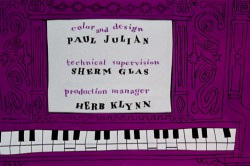
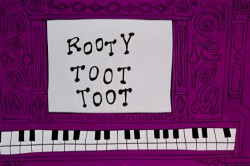
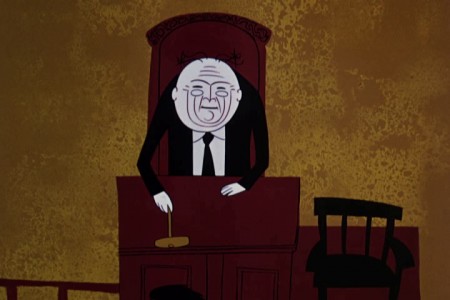 2
2
Gold colors dominate the opening of the trial,
except for Frankie’s bright red dress.

Frankie appears, to stand trial.
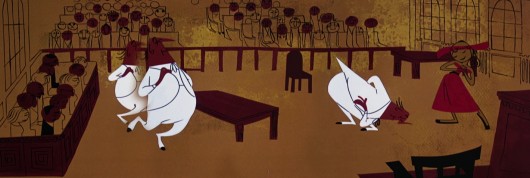
The defense does a dance with Frankie
as he caresses his client.
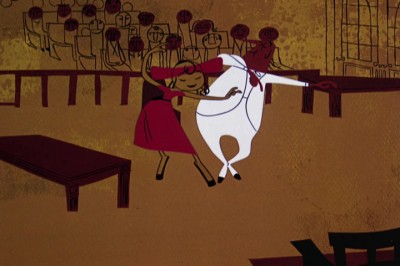 6
6
Choreographer Olga Lunick earned her money on this scene.
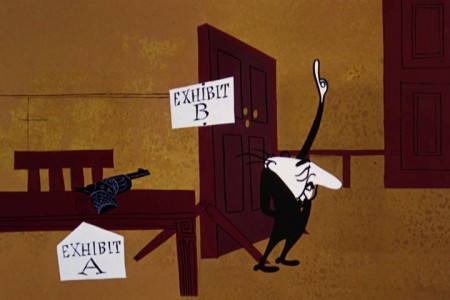 10
10
An open and shut kind of case.

The bartender is the first witness.
He waves hello to half those seated,
before raising his right hand to be sworn in.
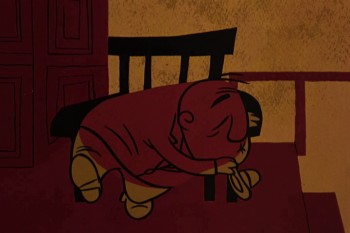 12
12
The bartender brings a subtle color change as
we move from gold hues to brownish colors.
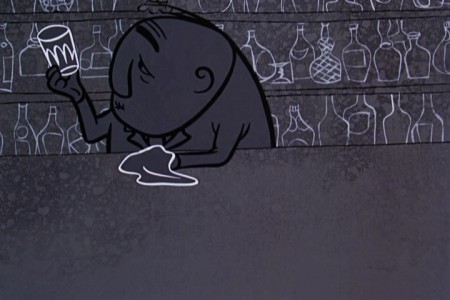 16
16
Once we go back to the bar, bluish grays take the scenes.
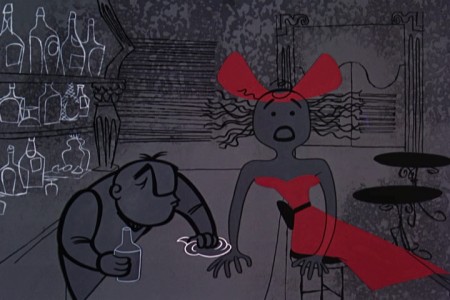 20
20
The bartender revealing Nellie Bly in the back room
foreshadows his reveal at the end of the film.
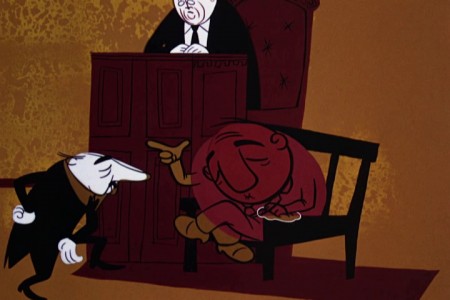 24
24
Back to the browns and ochres in the courtroom.
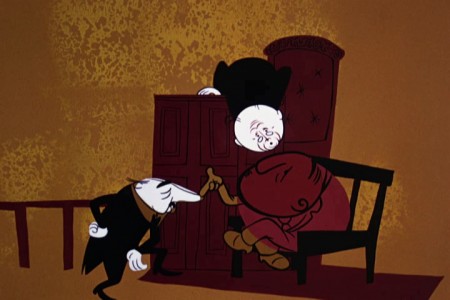 25
25
“Right in the snoot . . . ”
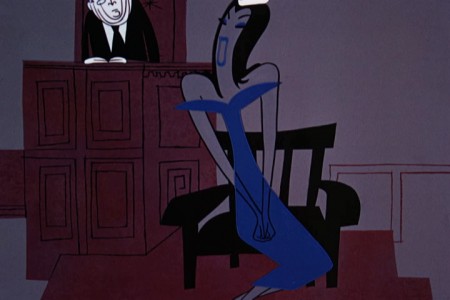 27
27
Nellie Bly brings her violets, lavenders and blues.
The exact opposite of Frankie’s colors.
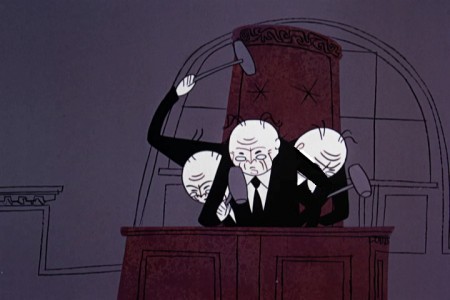 29
29
Order in the court.
The judge doesn’t smear; he breaks into multiple versions
of himself frenetically hammering his desk.
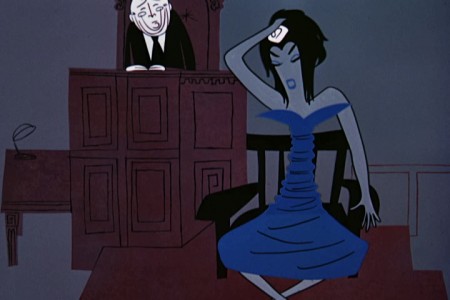 33
33
Straightening out the story . . .
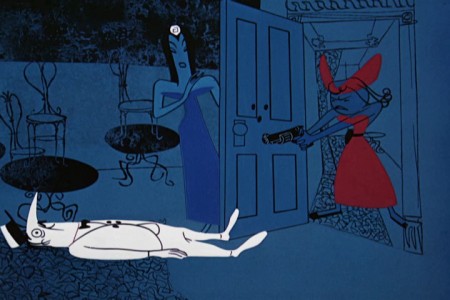 45
45
All blues except for that dress.
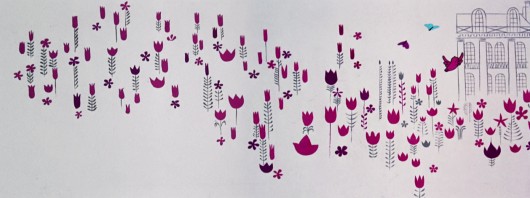
Frankie’s story comes in lily whites and white on white.
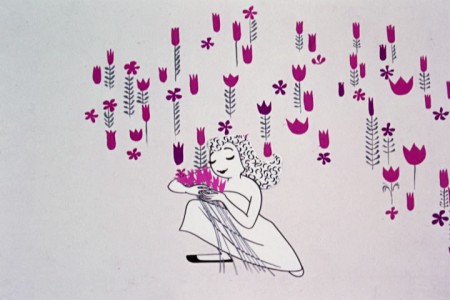 55
55
Her hair in this sequence was matted into the animation.
The decorative pattern didn’t move within the body of the hair.
A real pain in the butt for a design technique. Multiple camera runs.
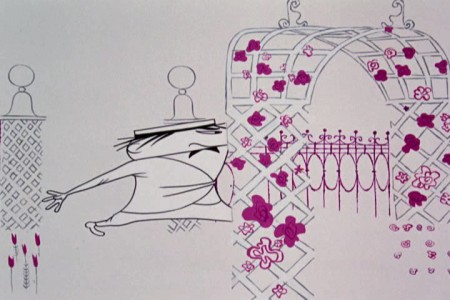 57
57
Smear frames are used in this sequnce for Johnny.
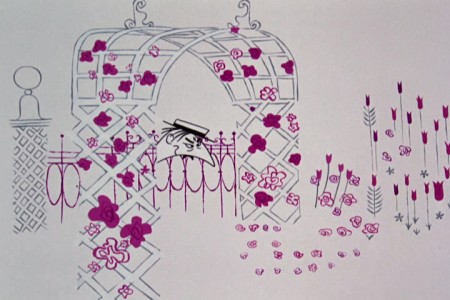 58
58
the victim is made to be the evil one.
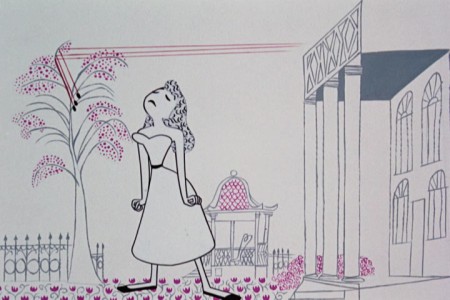 67
67
The bullets ricochet, musically, all over the place.
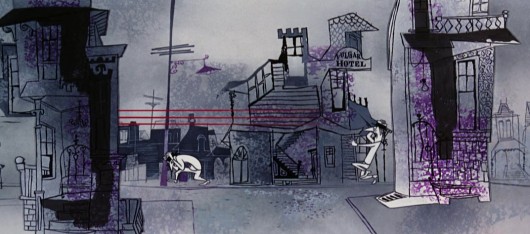
The pure whitish backgrounds turn to dirty grays.
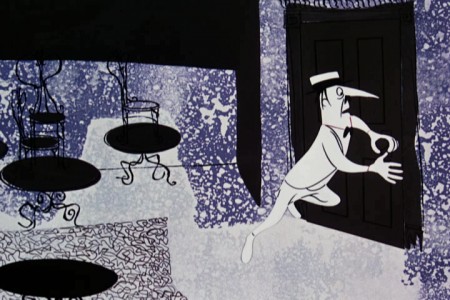 78
78
There’s a reuse of the gag as he looks out the door (see #40 on),
but the animation is different. No expense spared on this film.
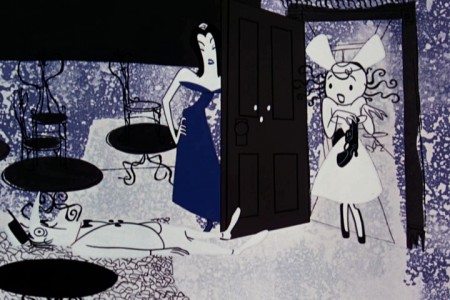 88
88
Back to the courtroom, vermillion is the color dominating.
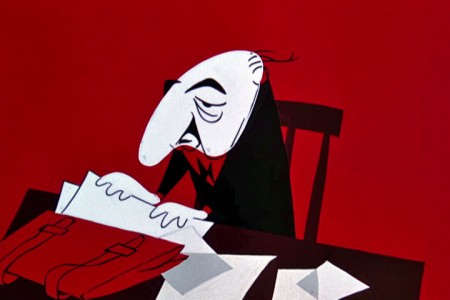 97
97
Back to the courtroom, vermillions turn to
deep reds as the innocent verdict is revealed.
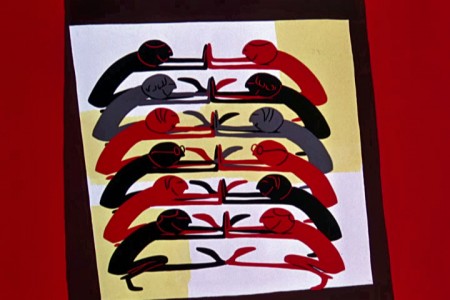 103
103
Very short quick scenes scream at the audience.
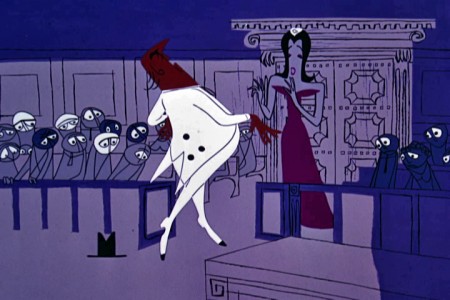 108
108
The attorney’s murder brings bright violets and lavenders.
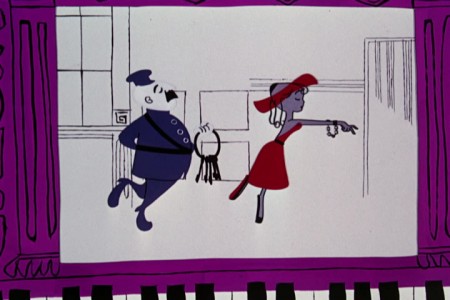 116
116
The lavenders dominate until we pull out
on the purple player piano.
This film, like Nordshtein’s Tale of Tales, is proof that animation can and should be as sophisticated as live action and as adult as any film. This is most certainly one of the classics in animation history. It’s only the animators and producers that hold the medium back.
